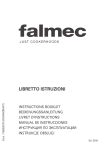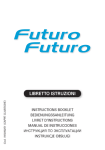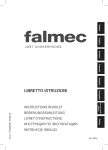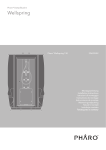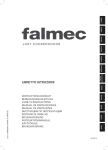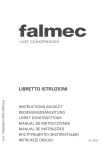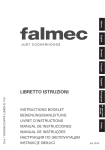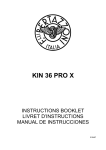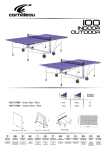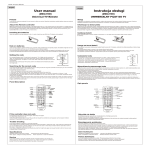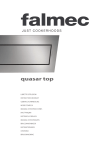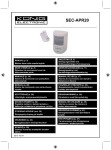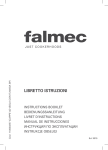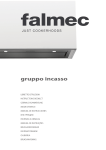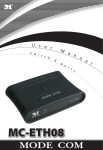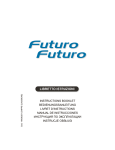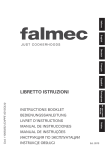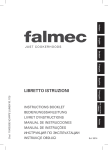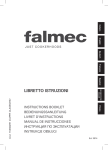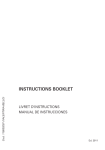Download LIBRETTO ISTRUZIONI
Transcript
LIBRETTO ISTRUZIONI Cod. 110030291 (CIELO) INSTRUCTIONS BOOKLET BEDIENUNGSSANLEITUNG LIVRET D’INSTRUCTIONS àçëíêìäñàü èé ùäëèãìÄíÄñàà INSTRUKCJE OBSŁUGI Ed. 2013 Gentile Signora/Signore, congratulazioni! Lei ha acquistato una cappa di prestigio e di sicura qualità. Perché Lei possa ottenere le migliori prestazioni, Le suggeriamo di seguire con attenzione le istruzioni per l’uso e manutenzione che troverà in questo libretto; inoltre, per ordinare i filtri di ricambio al carbone attivo utilizzi l’apposito tagliando che troverà allegato alla copertina. Dear Sir/Madam, congratulations! You have purchased a prestigious range hood of guaranteed quality. For best results, we suggest that you carefully follow the operating and maintenance instructions provided in this booklet; in addition, to order spare charcoal filters, use the special coupon on the cover. Verehrte Kundin, verehrter Kunde Kompliment! Sie haben eine qualitativ hochwertige Dunstabzugshaube erworben. Um ihre Leistungsfähigkeit optimal nutzen zu können, sollten Sie die beiliegende Gebrauchs- und Wartungsanleitung sorgfältig durchlesen und befolgen. Für die Bestellung der ErsatzAktivkohlefilter verwenden Sie bitte den Coupon, der dem Deckblatt beiliegt. Chère Madame/Cher Monsieur, félicitations! Vous venez d’acheter une hotte haut de gamme. Pour en tirer les performances les meilleures veuillez lire avec attention le mode d’emploi et la maintenance que vous trouvez dans ce manuel ; pour commander les filtres de rechange au carbone actif veuillez vous servir du coupon annexé à la couverture. Ç˚ ÔËÓ·ÎË ÔÒÚËÊÌÓ Ë ‚˚ÒÓÍÓ͇˜ÒÚ‚ÌÌÓ ‚˚ÚflÊÌÓ ÛÒÚÓÈÒÚ‚Ó. ÑÎfl ÚÓ„Ó, ˜ÚÓ·˚ ÓÌÓ ‰‡‚‡ÎÓ Ì‡ËÎÛ˜¯Ë ÁÛθڇÚ˚, ÍÓÏ̉ÛÏ ‚ÌËχÚθÌÓ ÒΉӂ‡Ú¸ ËÌÒÚÛ͈ËflÏ ÔÓ ˝ÍÒÔÎÛ‡Ú‡ˆËË Ë ÛıÓ‰Û, ÍÓÚÓ˚ ‚˚ Ì‡È‰Ú ‚ ˝ÚÓÏ ËÁ‰‡ÌËË; ÍÓÏ ÚÓ„Ó, ‰Îfl Á‡Í‡Á‡ Á‡Ô‡ÒÌ˚ı ÙËθÚÓ‚ ̇ ‡ÍÚË‚ËÓ‚‡ÌÌÓÏ Û„Î ËÒÔÓθÁÛÈÚ ÒԈˇθÌ˚È Ú‡ÎÓÌ, ÍÓÚÓ˚È ‚˚ ÏÓÊÚ Ì‡ÈÚË ÔËÍÔÎÌÌ˚Ï Í Ó·ÎÓÊÍ. Szanowni Państwo Gratulujemy! Zakupiliście prestiżowy okap kuchenny o gwarantowanej jakości. Dla uzyskania najlepszych wyników zalecamy, by starannie przestrzegać instrukcji obsługi i konserwacji zawartych w tej broszurze. Ponadto, do zamawiania zapasowych filtrów z węglem drzewnym, wykorzystywać specjalny kupon załączony na okładce. 1 2 3 4 5 6 7 I A LIBRETTO ISTRUZIONI AVVERTENZE È molto importante che questo libretto istruzioni sia conservato insieme all’apparecchiatura per qualsiasi futura consultazione. Se l’apparecchio dovesse essere venduto o trasferito ad un’altra persona, assicurarsi che il libretto venga fornito assieme, in modo che il nuovo utente possa essere messo al corrente del funzionamento della cappa e delle avvertenze relative. Queste avvertenze sono state redatte per la vostra sicurezza e per quella degli altri, Vi preghiamo, dunque, di volerlo leggere attentamente prima d’installare e di utilizzare l’apparecchio. Questo apparecchio non deve essere utilizzato da bambini o persone infermi a meno che non siano adeguatamente controllate da persone responsabili che si assicurino che l’apparecchio sia utilizzato in sicurezza. I bambini devono essere controllati da persona responsabile per assicurarsi che non giochino con l’apparecchio. Il lavoro di installazione deve essere eseguito, da installatori competenti e qualificati, secondo le norme in vigore. Se il cavo di alimentazione è danneggiato, esso deve essere sostituito dal costruttore o dal suo servizio assistenza tecnica o comunque da una persona con qualifica similare, in modo da prevenire ogni rischio. Ogni eventuale modifica che si rendesse necessaria all’impianto elettrico per installare la cappa dovrà essere eseguita solo da persone competenti. È pericoloso modificare o tentare di modificare le caratteristiche di questo impianto. In caso di riparazioni o mal funzionamento dell’apparecchio, non tentare di risolvere da soli il problema. Le riparazioni effettuate da persone non competenti possono provocare danni. Per eventuali interventi rivolgersi ad un Centro Assistenza Tecnica autorizzato ad eseguire parti di ricambio. Controllare sempre che tutte le parti elettriche, (luci, aspiratore), siano spente quando l’apparecchio non viene usato. Leggere tutto il libretto istruzioni prima di effettuare operazioni sulla cappa. L’utilizzo della cappa non può essere diverso da quello di aspiratori di fumi di cottura su cucine domestiche. Qualsiasi utilizzo diverso da questo solleva il costruttore da qualsiasi responsabilità. Il peso massimo complessivo di eventuali oggetti posizionatio appesi (ove previsto) sulla cappa non deve superare 1,5 Kg. Dopo l’installazione delle cappe in acciaio inox bisogna eseguire la pulizia della stessa per rimuovere i residui di collante protettivo e le eventuali macchie di grasso o oli. Per questa operazione il costruttore raccomanda l’utilizzo delle salviette in dotazione, disponibili anche in acquisto. L’utilizzo di altre tipologie di detergenti solleva il costruttore dalla responsabilità sui danni che ne potrebbero derivare. L’impianto elettrico è munito di collegamento a terra secondo le norme di sicurezza internazionali; è inoltre conforme alle normative Europee sull’antidisturbo radio. Non collegare l’apparecchio a condotti di scarico dei fumi prodotti dalla combustione (caldaie, caminetti,ecc). Verificare che la tensione di rete corrisponda a quella riportata dalla targhetta posta all’interno della cappa. Non fare cotture a fiamma “libera” sotto la cappa. Controllare le friggitrici durante l’uso: I’olio surriscaldato potrebbe infiammarsi. 8 - Assicurarsi che vi sia una adeguata ventilazione nella stanza se la cappa è utilizzata con altri apparecchi che utilizzano combustibili come gas o altro. - Non accendere fiamme libere sotto la cappa. - Non collegare l’apparecchio a condotti di scarico dei fumi prodotti dalla combustione (caldaie, caminetti, ecc). - Assicurarsi che tutte le normative vigenti sullo scarico dell’aria all’esterno del locale siano rispettate prima dell’utilizzo della cappa. Prima di procedere a qualsiasi operazione di pulizia o di manutenzione, disinserire l’apparecchio togliendo la spina o agendo sull’interruttore generale. La casa costruttrice declina ogni responsabilità per eventuali danni che possano, direttamente o indirettamente, essere causati a persone, cose ed animali domestici in conseguenza alla mancanza di tutte le prescrizioni indicate nell’apposito libretto istruzioni e concernenti, specialmente, le avvertenze in tema di installazione, uso e manutenzione dell’apparecchio. - Rischio di incendio se la pulizia non è condotta secondo le istruzioni del presente libretto. ATTENZIONE: parti accessibili possono essere calde quando usate con apparecchi di cottura. AVVERTENZA: l’installazione delle viti o dei dispositivi di fissaggio non conforme alle presenti istruzioni può comportare rischi di natura elettrica. B CARATTERISTICHE TECNICHE I dati tecnici dell’elettrodomestico sono riportati su delle targhette, posizionate all’interno della cappa. C INSTALLAZIONE (parte riservata solo a persone qualificate per il montaggio della cappa) La distanza, fra piano cottura e parte inferiore della cappa, consigliata per l’installazione è di circa 110 cm. In casi limiti, perdendo un po’ di efficienza, la distanza può essere incrementata a circa 150 cm. La distanza minima non può essere inferiore a 65 cm come previsto dalla normativa. Se le istruzioni del piano di cottura a gas specificano una distanza maggiore, bisogna tenerne conto. Istruzioni di montaggio: vedi sez. “M” del presente manuale. D ALLACCIAMENTO ELETTRICO (parte riservata solo a persone qualificate per l’allacciamento) ATTENZIONE! Prima di effettuare qualsiasi operazione all’interno della cappa scollegare l’apparecchio dalla rete elettrica. Assicurarsi che non vengano scollegati o tagliati fili elettrici all’interno della cappa; nel caso si verifichino tali situazioni contattare il centro assistenza più vicino. Per l’allacciamento elettrico rivolgersi a personale qualificato. Il collegamento deve essere eseguito in conformità con le disposizioni di legge in vigore. Controllare che la valvola limitatrice e l’impianto elettrico possano sopportare il carico dell’apparecchio (vedere targhetta caratteristiche tecniche al punto B). Alcuni tipi di apparecchi possono essere dotati di cavo senza spina; in questo caso, la spina da utilizzare deve essere dei tipo “normalizzato” tenendo conto che: - il filo giallo-verde deve essere utilizzato per la messa a terra, - il filo blu deve essere utilizzato per il neutro, - il filo marrone deve essere utilizzato per la fase, il cavo non deve entrare in contatto con parti calde aventi temperature superiori a 70°C. 9 - montare sul cavo di alimentazione una spina adatta al carico e collegarla ad una adeguata spina di sicurezza. Se un apparecchio fisso non è provvisto di cavo di alimentazione e di spina, o di altro dispositivo che assicuri la disconnessione dalla rete, con una distanza di apertura dei contatti che consenta la disconnessione completa nelle condizioni della categoria di sovratensione III, le istruzioni devono indicare che tali dispositivi di disconnessione devono essere previsti nella rete di alimentazione conformemente alle regole di installazione. Il cavo di terra giallo/verde non deve essere interrotto dall’interruttore. Prima di collegare l’apparecchio alla rete elettrica, controllare che: - la tensione d’alimentazione corrisponda a quella indicata dalla targhetta caratteristiche tecniche. - la presa di terra sia corretta e funzionale. - l’impianto di alimentazione sia munito di efficace collegamento di terra secondo le norme vigenti. - la presa o l’interruttore omnipolare usati siano facilmente raggiungibili con l’apparecchiatura installata. La casa costruttrice declina ogni responsabilità nel caso le norme di sicurezza non vengano rispettate. E CAPPA IN VERSIONE A RICICLO INTERNO La cappa cielo è disponibile solo in versione a ricircolo interno con filtri carbone. Per la sostituzione vedi sez. G1. F FUNZIONAMENTO PULSANTIERA ELETTRONICA 1: Timer Luce ROSSA lampeggiante sta ad indicare che la funzione timer è attiva. Tale funzione è attivabile solo se alla pressione del tasto (prolungata o meno) il motore è già attivo ad una velocità qualsiasi. Tale funzione determina l’autospegnimento della cappa dopo 15 minuti. Con la funzione Timer attiva, la cappa può essere in ogni caso spenta dall’utente e la funzione verrà disattivata. La funzione Timer rimane associata ad una velocità. Il cambio della velocità, con la funzione timer attiva, implica la disattivazione di quest’ultima. 2: 1° Velocità Nella situazione di LED spento, la pressione non prolungata del tasto implica l’accensione della cappa al la 1° velocità e l’accensione del relativo LED. La funzione si attiverà al rilascio del tasto. Nella situazione di LED spento ed un’altra velocità attiva, la pressione del tasto implica la selezione della 1° velocità, l’accensione del relativo LED e lo spegnimento del LED associato alla velocità precedentemente selezionata. A LED accesso la pressione del tasto implica lo spegnimento del LED e del MOTORE. A LED spento la pressione prolungata (almeno 3sec) del tasto implica l’attivazione della funzione ricircolo. Durante la funzione ricircolo (della durata 24 ore), il LED lampeggia. Dall’attivazione di tale funzione, la cappa resta accesa per 1 ora alla 1° velocità, poi si ferma per 3 ore e si riattiva per un’altra ora. Tali cicli vengono ripetuti fino al timeout. Con questa funzione attivata non si possono selezionare le altre velocità. Per Togliere questa funzione, tenere premuto per almeno 3 secondi il tasto 2. 3: 2° Velocità Nella situazione di LED spento ed un’altra velocità attiva, la pressione del tasto (prolungata o meno) implica la selezione della 2° velocità, l’accensione del relativo LED e lo spegnimento del LED associato alla velocità precedentemente selezionata. 10 Nella situazione di LED spento e nessuna velocità attiva, la pressione del tasto non ha effetto. A LED accesso la pressione del tasto3 non ha effetti. Per spegnere la cappa occorre selezionare prima la 1° velocità, poi premere nuovamente tale tasto. 4: 3° Velocità Nella situazione di LED spento ed un’altra velocità attiva, l a pressione del tasto (prolungata o meno) implica la selezione della 3° velocità, l’accensione del relativo LED e lo spegnimento del LED associato alla velocità precedentemente selezionata. Nella situazione di LED spento e nessuna velocità attiva, la pressione del tasto non ha effetto. A LED accesso la pressione del tasto4 non ha effetti. Per spegnere la cappa occorre selezionare prima la 1° velocità, poi premere nuovamente tale tasto. 5: 4° Velocità Nella situazione di LED spento ed un’altra velocità attiva, la pressione(prolungata o meno) del tasto implica la selezione della 4° velocità, l’accensione del relativo LED e lo spegnimento del LED associato alla velocità precedentemente selezionata. Nella situazione di LED spento e nessuna velocità attiva, la pressione del tasto non ha effetto. A LED accesso la pressione del tasto5 non ha effetti. La quarta velocità deve restare accesa per massimo 14 minuti, dopo di che si deve ritornare alla terza. Per spegnere la cappa occorre selezionare prima la 1° velocità, poi premere nuovamente tale tasto. 6: Luce – Associazione del radiocomando Luce: La pressione breve del tasto T6 accende e spegne la luce. Il tasto T6 si illumina se la luce è accesa. Associazione del radiocomando: Con motore e luce spenta, la pressione lunga del tasto T6 attiva la modalità di associazione del telecomando. Il Tasto T6 lampeggia per un massimo di 10 secondi. Durante il lampeggio deve essere premuto almeno un tasto del radiocomando. La funzione si disattiva allo scadere dei 10 secondi o prima se viene rilevato un telecomando compatibile. Gestione della pressione dei tasti: Pressione prolungata = dito presente sul tasto per almeno 3 secondi, la funzione si attiva durante la pressione. Pressione non prolungata = dito presente sul tasto per meno di 3 secondi, la funzione di attiva al rilascio. Radiocomando : Posizionare l’apparecchio lontano da sorgenti di onde elettromagnetiche che potrebbero interferire con l’elettronica della cappa. Distanza massima di funzionamento 4 metri. Tale distanza può variare in difetto in funzione delle interferenze elettromagnetiche di altri apparecchi. Funzionamento del Radiocomando Tasto Luce La pressione del tasto Luce accende/spegne la luce Tasto ‘ - ‘ La pressione del tasto ‘-’ decrementa la velocità del motore. Se si è in 1° velocità, la pressione del tasto ‘-’ spegne il motore Tasto ‘ + ‘ Se il motore è spento, la pressione del tasto ‘+’ attiva il motore alla 1° velocità. Se il motore è in funzione, la pressione del tasto ‘+’ incrementa la velocità fino alla massima. Tasto Timer Se il motore è attivo, la pressione del tasto timer attiva/disattiva la funzione timer Cambio Codice (solo in caso di malfunzionamento) 11 Premere il tasto “Luce” insieme al tasto “Timer” del radiocomando fino a che il led blu non inizia a lampeggiare lentamente. Se entro 5 secondi si preme il tasto “-” del radiocomando viene generato e memorizzato il nuovo codice. La memorizzazione viene confermata da 3 lampeggi brevi del led. Per ritornare al codice di default bisogna premere il tasto “-” insieme al tasto “+” del radiocomando per più di 5 secondi. La memorizzazione del codice di default viene segnalata con 3 brevi lampeggi del led. Ogni volta che viene generato un nuovo codice o impostato il codice di default nel telecomando, bisogna eseguire anche la procedura Associazione del radiocomando (Tasto Luce della pulsantiera) descritta precedentemente. G FILTRI METALLICI E FILTRI A CARBONE 1. FILTRI METALLICI Per accedere ai filtri metallici aprire il pannello P (vedi fig. G1). Per rimuovere il filtro metallico antigrasso agire sulla maniglia “A” (vedi figura G1 –part. 1-2). 2. FILTRI AL CARBONE ATTIVO Per la sostituzione dei filtri carbone vedi fig. G2. I filtri sono fissati al corpo cappa mediante magneti. Codice ricambio del kit completo filtri a carbone lavabile (4 filtri type A + 2 filtri type B): KCL.932. SOLO PER ITALIA: Scaricare l’apposito modulo ordine filtro sul sito: www.falmec.com (accedere sul menù a tendina assistenza). H ILLUMINAZIONE MONTAGGIO E SOSTITUZIONE La cappa è dotata di illuminazione con faretti led ad alta efficienza, basso consumo e durata molto elevata in condizioni di normale utilizzo. La sostituzione del faretto led deve essere fatta solo da tecnici qualificati utilizzando solo ricambi originali. I MANUTENZIONE E PULIZIA Una costante manutenzione garantisce un buon funzionamento ed un buon rendimento nel tempo. Particolari attenzioni vanno rivolte ai filtri metallici antigrasso ed ai filtri al carbone attivo, infatti la pulizia frequente dei filtri e dei loro supporti garantisce che sulla cappa non si accumulino grassi che sono pericolosi per la facilità di incendio. 1. FILTRO ANTIGRASSO METALLICI Hanno la funzione di trattenere le particelle grasse in sospensione, pertanto si consiglia di lavarli ogni mese in acqua calda e detersivo evitando di piegarli. Attendere che siano ben asciutti prima di rimontarli. Per lo smontaggio e montaggio vedi istruzioni al punto G1. Si raccomanda costante frequenza nell’operazione. 12 2. FILTRI AL CARBONE ATTIVO Hanno la funzione di trattenere gli odori presenti nel flusso d’aria che li attraversa. L’aria depurata per successivi passaggi attraverso i filtri viene rimessa nell’ambiente cucina. I filtri al carbone attivo della cappa cielo possono essere riattivati lavandoli in lavastoviglie con un normale detergente ad una temperatura di max. 65 °C e possibilmente da solo. Dopo il lavaggio riattivare il filtro in un forno ad una temperatura di 100°C per 30 minuti. La massima durata del filtro con una accettabile efficienza è di 2/3 anni con massimo 10 lavaggi per anno. 3. PULIZIA ESTERNA Si raccomanda di pulire le superfici esterne delle cappe almeno ogni 15 giorni per evitare che le sostanze oleose o grasse possano intaccare le superfici in acciaio. La pulizia della cappa va eseguita usando un panno umido con detersivo liquido neutro o con alcool denaturato. Nel caso di materiale con trattamento antimpronta (Fasteel) eseguire la pulizia solo con acqua e sapone neutro utilizzando un panno morbido avendo cura di risciacquare e asciugare accuratamente. Non si devono utilizzare prodotti contenenti sostanza abrasive, panni con superfici ruvide o panni comunemente in commercio per la pulizia dell’acciaio. L’utilizzo di sostanze abrasive e panni ruvidi danneggerà irreparabilmente il trattamento superficiale dell’acciaio. Conseguenza diretta del non rispetto di tali avvertenze sarà il deterioramento irreversibile della superficie dell’acciaio. Tali avvertenze dovranno essere conservate insieme al libretto istruzioni della cappa. Il produttore declina ogni responsabilità qualora non vengano rispettate tali istruzioni. 4. PULIZIA INTERNA É vietata la pulizia di parti elettriche o parti relative al motore all’interno della cappa, con liquidi o solventi; Non usare prodotti contenenti abrasivi. Effettuare tutte queste operazioni scollegando preventivamente l’apparecchio dalla rete elettrica. L GARANZIA La sua nuova apparecchiatura è coperta da garanzia. Le condizioni di garanzia sono riportate per esteso sull’ultima pagina di copertina di questo libretto. La casa costruttrice non risponde delle possibili inesattezze, imputabili ad errori di stampa o di trascrizione, contenute nel presente libretto. Si riserva di apportare ai propri prodotti quelle modifiche che ritenesse necessarie o utili, anche nell’interesse dell’utenza, senza pregiudicare le ca ratteristiche essenziali di funzionalità e di sicurezza. M MONTAGGIO CAPPA Fig. A 1) Togliere i tappi in gomma e accedere alle 4 viti metriche “V2” per allentarle senza rimuoverle. Queste viti trattengono il supporto “SP” pre-montato sulla cappa. 2) Rovesciare la cappa dopo aver posizionato sotto di essa un telo protettivo. Fig. B Rimuovere il supporto cappa “SP” pre-montato sulla cappa come illustrato in figura. 13 Fig. C 1) Fissare il supporto “SP” al soffitto mediante le 6 viti “V3” e i tasselli in dotazione. Prestare attenzione che il cavo di alimentazione “CAI” non rimanga schiacciato. 2) Verificare la tenuta e la solidità dell’installazione. Fig. D 1) Alzare la cappa in prossimità del supporto “SP”. Disinserire l’alimentazione elettrica che alimenta la cappa ed eseguire il collegamento elettrico fra il cavo di alimentazione dell’impianto “CAI” e il cavo alimentazione cappa “CAC” mediante una morsettiera “M” rispettando le norme vigenti. 2) Traslare lateralmente la cappa per agganciarla alle 4 viti metriche “V2” del supporto “SP”. Quando la cappa è in posizione, serrare definitivamente le 4 viti “V2”. Avvitare le 4 viti “V4” di sicurezza per bloccare ulteriormente il corpo cappa al supporto “SP”. Fig. E Fissare il mantello in vetro “VC” alla cappa con 4 perni zigrinati metrici “V5” e collegare il morsetto della tastiera all’elettronica della cappa come illustrato in figura. Fig. F Agganciale la porta “P” della cappa e gli elementi laterali “EL” come illustrato in figura. Fig. G Fissare alla cappa gli elementi laterali “EL” e i filtri carbone “FC” come illustrato in figura (ATTENZIONE !! al verso di montaggio dei filtri: vedi figura G2). Fig. H Inserire i kit filtri metallici antigrasso con filtro alla zeolite come illustrato in figura. Chiudere la porta “P” e alimentare elettricamente la cappa rispettando le norme vigenti. 14 GB A INSTRUCTIONS BOOKLET WARNINGS This instruction booklet must be kept together with the appliance for future reference. If the appliance is sold or consigned to other parties, check that the booklet is supplied with it, to ensure that the new user has the correct information on the operation of the range hood and is aware of the warnings. These warnings have been provided for the your safety and the safety of others. As a result, please read them carefully before installing and operating the appliance. This appliance is not intended for use by young children or infirm persons unless they have been adequately supervised by a responsible person to ensure that they can use the appliance safely. Young children should be supervised to ensure they do not play with the appliance. The appliance must be installed by qualified personnel, in accordance with the standards in force. If the supply cord is damaged, it must be re-placed by the manufacturer, its service agent or similarly qualified persons in order to avoid a hazard. Any modifications that may be required to the electrical system for the installation of the range hood must only be made by qualified electricians. It is dangerous to modify or attempt to modify the characteristics of this system. In the event of malfunctions or if repairs are required to the appliance, do not attempt to solve the problems directly. Repairs performed by unqualified persons may cause damage. For all repair and other work on the appliance, contact an authorised service/spare parts centre. Always check that all the electrical parts (lights, exhaust device), are off when the appliance is not being used. Read the entire instruction booklet before performing any operations on the range hood. The range hood must only be used for the exhaust of cooking fumes in home kitchens. The manufacturer disclaims all liability for any other use of the appliance. The maximum weight of any object placed above the hood, or hung to it (if possible) must not exceed 1,5 kilos. After installing the stainless steel hood, clean it in order to remove any residue of the protective glue, and stains of grease or oil. The manufacturer recommends its cleaning cloth available for purchase. The manufacturer accepts no liability in case of damage caused by the use of different detergent types. The electrical system features an earth connection in compliance with international safety standards; furthermore, it is compliant with the European standard for electromagnetic compatibility. Do not connect the appliance to flues (from boilers, fireplaces, etc.). Make sure the mains voltage corresponds to the values on the rating plate located inside the range hood. Never cook on “open” flames under the range hood. Check deep-fryers during use: superheated oil may be flammable. - Ensure there is adequate ventilation of the room when the rangehood is used at the same time as appliances burning gas or other fuels. - Do not flambe under the rangehood - The exhaust air must not be discharged into a flue which is used for exhausting fumes from appliances burning gas or other fuels. - Ensure that all regulations concerning the discharge of exhaust air have been fulfilled before you use the appliance. Before performing any cleaning or maintenance operations, disconnect the appliance by unplugging it or using the main switch. The manufacturer disclaims all liability for any damage that may be directly or indirectly caused to people, things and animals due to the failure to 15 follow all the instructions provided in this booklet and above all the warnings relating to the installation, operation and maintenance of the appliance. - there is a fire risk if cleaning is not carried out in accordance with the instructions. CAUTION: Accessible parts may become hot when used with cooking appliances. WARNING: Failure to install the screws or fixing device in accordance with these instructions may result in electrical hazards. Warning only for Australia: hood width less than 90 cm: use max. 4 hobs B TECHNICAL SPECIFICATIONS The technical data pertaining to the electric appliance The technical specifications of the appliance are shown on the rating plates located inside the range hood. C INSTALLATION (Section reserved for qualified installers of the range hood) The recommended distance between the cooker and the lower part of the range hood for the installation is about 110 cm. In borderline cases, with a slight efficiency loss, the distance can be increased to about 150 cm. The minimum distance cannot be less than 65 cm, as envisioned by the Standard. Should the instructions of the gas cooker specify a greater distance, take this into consideration. Assembly instructions: see section “M” of the booklet. D ELECTRICAL CONNECTIONS (Section reserved for qualified installers) WARNING! Before doing any work inside the range hood, disconnect the appliance from the mains power supply. Check that the wires inside the range hood are not disconnected or cut; if this is the case, contact your nearest service centre. The electrical connections must be performed by qualified personnel. The connections must be performed in compliance with the legal standards in force. Check that the relief valve and the electrical system are able to support the load of the appliance (see the technical specifications in point B). Some types of appliance are supplied with a cable without plug; in this case, “standardised” plugs must be used, keeping in mind that: - the yellow-green wire must be used for the earth, - the blue wire must be used for the neutral, - the brown wire must be used for the phase; the cable must not come into contact with hot parts (over 70°C). - fit a plug that is suitable for the load to the power cable, and connect it to a suitable power outlet. For appliances that come supplied with cable and plug please ensure they are plugged into a circuit suitable for this appliance. Please refer to a qualifed person. (See technical specifications in point B). The manufacturer declines all liability if the safety standards are not observed. 16 E INTERIOR RECIRCULATING HOOD VERSION The sky hood is only available in the interior recirculating version with carbon filters. For replacement, please see sect. G1. F ELECTRONIC PUSH BUTTON CONTROL PANEL OPERATION 1: Timer Flashing RED light indicates that the timer function is active. This function can only be enabled if the motor is already active at any speed when the corresponding key is pressed (long press or not). This function activates the auto power off function of the hood after 15 minutes. With the Timer function active, the hood can be turned off by the user and the function will be disabled. The Timer function remains associated to a speed. Changing the speed with the timer function active involves the deactivation of the latter. 2: 1st Speed If the LED is off, the key a non-prolonged pressure of the key activates the hood at the 1st speed as well as the related LED. The function is activated by releasing the key. By pressing the key, if the LED is off and another speed is active, you can select the 1st speed, turn the related LED on, and turn the LED associated to the previously selected speed off. When the LED is on and the key is pressed, both the LED and MOTOR will turn off. When the LED is off, if the key is pressed for at least 3 seconds, the recirculation function activates. During the recirculation function (which lasts 24 hours), the LED flashes . From the activation of this function, the hood will remain active for 1 hour at the 1st speed, then it will stop for 3 hours and reactivate for one more hour. These cycles are repeated until timeout. With this feature enabled, you cannot select other speeds. To Disable this function, hold key 2 for at least 3 seconds. 3: 2nd Speed By pressing the key (long press or not), if the LED is off and another speed is active, you can select the 2nd speed, turn the related LED on, and turn the LED associated to the previously selected speed off. If the LED is off and no speed is active, pressing the key has no effect. When the LED is on, pressing key 3 has no effect. To turn off the hood, first select the 1st speed, then press that key again. 4: 3rd Speed By pressing the key (long press or not), if the LED is off and another speed is active, you can select the 3rd speed, turn the related LED on, and turn the LED associated to the previously selected speed off. If the LED is off and no speed is active, pressing the key has no effect. When the LED is on, pressing key 4 has no effect. To turn off the hood, first select the 1st speed, then press that key again. 5: 4th Speed By pressing the key (long press or not), if the LED is off and another speed is active, you can select the 4th speed, turn the related LED on, and turn the LED associated to the previously selected speed off. If the LED is off and no speed is active, pressing the key has no effect. When the LED is on, pressing key 5 has no effect. The fourth speed must remain on for a maximum of 14 minutes, after which it must return to the third. 17 To turn off the hood, first select the 1st speed, then press that key again. 6: Light – Associating a radio control Light: By shortly pressing T6 key, you can turn the light on and off. T6 key will light up if the light is on. Associating a radio control: Applying prolonged pressure on T6 key with the motor and light off will enable the remote binding mode. T6 key will flash for a maximum of 10 seconds. During flashing, at least one radio control key must be pressed. The function will deactivate at the end of the 10 seconds, or earlier if a compatible remote control is detected. Key pressure management : Prolonged pressure = finger on key for at least 3 seconds, the function activates during pressure. Non-prolonged pressure = finger on key for less than 3 seconds, the function activates when it is released. Radio control: Place the device far from sources of electromagnetic waves which could interfere with the hood electronic functions. Maximum operating distance 4 metres. This distance may vary in defect based on the electromagnetic interference of other devices. Radio control operation Light Key By pressing the Light key, the light is switched on/off Key ‘ - ‘ By pressing the ‘-’ key, the motor speed is decreased. If the 1st speed is active, by pressing the ‘-’ key, the motor is turned off. ‘ + ‘ Key If the motor is turned off, by pressing the ‘+’ key, the motor is enabled at the 1st speed. If the motor is running, by pressing the ‘+’ key, the motor speed is increased to the top. Timer Key If the motor is active, by pressing the timer key the timer function is enabled/ disabled Code Change (only in case of malfunction) Press the “Luce” (Light) key together with the “Timer” key of the radio control until the blue LED begins to slowly flash. If the “-” key of the radio control is pressed within 5 seconds, the new code will be generated and memorized. Memorisation is confirmed by 3 short flashes of the LED. To return to the default code, press the “-” and “+” keys together for over 5 seconds. The default code memorization of the default code will be signalled with 3 short flashes of the LED. henever a new code is generated or the default code is set in the remote control, it is necessary to also carry out the previously described procedure related to Associating a radio control (Light Key of the push button control panel). G METAL FILTERS AND CARBON FILTERS 1. METAL FILTERS To access the metal filters open the panel P (see fig. G1). To remove the grease-trapping metal filter, use handle “A” (see figure G1 – detail 1-2). 18 2. ACTIVATED CARBON FILTERS To replace the carbon filters see fig. G2. The filters are fixed to the hood body using magnets. Replacement code of the complete kit of washable carbon filters (4 filters type A + 2 filters type B): KCL.932. ONLY FOR ITALY: Download the specific filter order form from www.falmec.com (access the drop-down assistance menu). H LIGHTING ASSEMBLY AND REPLACEMENT The range hood is equipped with high efficiency, low consumption LED spotlights with extremely long duration under normal use conditions. The LED lamp must be replaced only by qualified technicians using only original spare parts. I MAINTENANCE AND CLEANING Constant maintenance ensures the correct operation and efficiency of the appliance over time. Special attention should be paid to the metal grease-trapping filters and the charcoal filters. Frequent cleaning of the filters and their supports will ensure that fats and grease do not accumulate on the range hood, with the consequent risk of fire. 1. GREASE-TRAPPING METAL FILTER They retain suspended grease particles; therefore, we recommend washing them in hot water, paying attention not to bend them. Wait for them to dry completely before remounting them. For assembly and disassembly instructions, see section G1. We recommend performing this operation with regularly. 2. ACTIVATED CARBON FILTERS They have the function of retaining odours in the air flow passing through them. The air, purified by running many times through the filter, is recirculated into the kitchen. The active carbon filters of the sky hood can be reactivated by washing them in the dishwasher with a normal detergent at a maximum temperature of 65° C and preferably alone. After washing, reactivate the filter in an oven at a temperature of 100° C for 30 minutes. The maximum duration of the filter with an acceptable efficiency is 2/3 years with a maximum of 10 washings per year. 3. CLEANING THE OUTSIDE OF THE APPLIANCE It is advised to clean the external hood surfaces at least every 15 days in order to avoid that oily or greasy substances affect the steel surfaces. The ouside of the range hhod should be cleaned using a damp cloth and neutral liquid detergent or denatured alcohol. In case of fingerprint-less finish (fasteel) clean only with water and neutral soap using clean with a soft cloth, rinse and wipe dry thoroughly. Do not use products that contain abrasive substances, rough cloths or cloths specifically designed for cleaning steel. Using abrasive substances or rough cloths will inevitably damage the finish of steel. The steel surface will be irrevocably damaged if the instructions above are not complied with. Keep these instructions together with the instructions for use of your hood. The manufacturer accepts no liability for any damage caused by non-compliance with the instructions above. 4. CLEANING THE INSIDE OF THE APPLIANCE The electrical parts or parts of the motor assembly inside the range hood must not be cleaned using liquids or solvents. 19 Do not use abrasive products. All the above operations must be performed after having disconnected the appliance from the mains power supply. L WARRANTY The new equipment is covered by warranty. The warranty conditions are provided by the distributor. The manufacturer is not liable for any inaccuracies in this booklet resulting from printing or transcription errors. The manufacturer reserves the right to modify its products as it considers necessary or in the interests of the user, without compromising their essential safety and operating characteristics. M RANGE HOOD ASSEMBLY Fig. A 1) Remove the rubber caps and turn the 4 “V2” metric screws, loosening them without removing them. These screws keep the pre-assembled “SP” support on the hood. 2) Turn the hood over, after putting a protective sheet under it. Fig. B Remove the pre-assembled “SP” hood support as shown in the figure. Fig. C 1) Fix the “SP” support to the ceiling using 6 “V3” screws and the supplied plugs. Make sure the “CAI” supply cable does not remain crushed. 2) Check the tightness and solidity of the installation. Fig. D 1) Lift the hood near the “SP” support. Disconnect the hood’s power supply and make the electrical connection between the “CAI” system supply cable and the “CAC” hood supply cable, using terminal board “M” in compliance with current standards. 2) Move the hood sideways and hook it to the 4 “V2” metric screws of the “SP” support. When the hood is in place, fully tighten the 4 “V2” screws. Tighten the 4 “V4” safety screws to further lock the hood body to the “SP” support. Fig. E Fasten the “VC” glass sleeve to the hood using 4 “V5” knurled metric pins and connect the keyboard terminal to the hood electronics as shown in the figure. Fig. F Hook them to hood door “P” and side components “EL” as shown in the figure. Fig. G Fasten the hood to components “EL” and carbon filters “FC”, as shown in the figure (pay ATTENTION to the assembly direction of the filters: see figure G2). Fig. H Insert the grease-trapping metal filter kits with zeolite filters as shown in the figure. Close door “P” and switch on the hood power supply complying with the current standards. 20 Insert the grease-trapping metal filter kits with zeolite filters as shown in the figure. Close D door “P” and switch on the hood power supply complying with the current standards. BEDIENUNGSANLEITUNG A HINWEISE Diese Bedienungsanleitung muss unbedingt zusammen mit dem Gerät aufbewahrt werden, um in Zukunft nachgeschlagen werden zu können. Sollte das Gerät verkauft bzw. einer anderen Person übergeben werden, muss die Bedienungsanleitung unbedingt mitgeliefert werden, damit der neue Benutzer mit dem Betrieb der Dunstabzugshaube und den diesbezüglichen Hinweisen vertraut werden kann. Diese Hinweise sind für Ihre Sicherheit und die anderer Personen abgefasst worden. Daher sollten Sie die Bedienungsanleitung vor der Installation und Verwendung des Gerätes aufmerksam durchlesen. Das Gerät darf nicht von Kindern bzw. Behinderten benutzt werden, es sei denn diese werden von verantwortungsvollen Personen, die dafür Sorge tragen, dass das Gerät sicher verwendet wird, überwacht. Kinder müssen von einer von verantwortungsvollen Person überwacht werden, damit sie nicht mit dem Gerät spielen. Die Installation hat den geltenden Vorschriften gemäß von kompetenten, qualifizierten Installateuren durchgeführt zu werden. Beschädigte Speisekabel sind vom Hersteller bzw. von dessen Kundenservice bzw. von einer Person mit ähnlicher Qualifikation auszuwechseln, um Gefahren vorzubeugen. Eventuelle erforderliche Änderungen, die für die Installation der Dunstabzugshaube an der elektrischen Anlage durchgeführt werden müssen, dürfen ausschließlich von kompetenten Personen vorgenommen werden. Es ist gefährlich, die Eigenschaften dieser Anlage abzuändern bzw. versuchen abzuändern. Bei Reparaturen bzw. Betriebsstörungen des Gerätes nicht versuchen, das Problem alleine zu lösen. Die Reparaturen, die von nicht kompetenten Personen durchgeführt werden, können Schäden verursachen. Sich für eventuelle Eingriffe an einen zugelassenen Kundenservice, der über die geeigneten Ersatzteile verfügt, wenden. Wenn das Gerät nicht benutzt wird, müssen alle elektrischen Teile (Beleuchtung, Absaugvorrichtung) ausgeschaltet sein. Vor Durchführung von Arbeitsvorgängen an der Dunstabzugshaube die Bedienungsanleitung lesen. Die Dunstabzugshaube darf ausschließlich zum Absaugen des Dampfes, der beim Kochen in einer Haushaltsküche entsteht, verwendet werden. Bei anderen Einsätzen wird der Hersteller von jeder Haftung befreit. Das Gesamtgewicht von Gegenständen, die eventuell auf die Dunstabzugshaube positioniert bzw. an diese gehängt werden (falls vorgesehen), darf höchstens 1,5 Kg betragen. Nach der Installation von Edelstahlhauben muss man diese reinigen, um Schutzkleberreste und eventuelle Fett- und Ölflecken zu entfernen. Der Hersteller empfiehlt für doesen Arbeitsvorgang die Verwendung der mitgelieferten Reinigungstücher. Die Verwendung anderer Reinigungsmittel befreit den Hersteller von jeder Haftung für eventuelle auf deren Benutzung zurückzuführende Schäden. Die elektrische Anlage ist mit einer Erdung ausgestattet, die den internationalen Sicherheitsvorschriften entspricht; sie erfüllt außerdem die europäischen Entstörungsvorschriften. Das Gerät auf keinen Fall an die Ablassleitungen von Rauch, das durch Verbrennung entsteht (Heizkessel, Kamine, usw...), anschließen. Sich vergewissern, dass die Netzspannung mit den im Inneren der Dunstabzugshaube angegebenen Daten übereinstimmt. 21 Auf keinen Fall unter der Dunstabzugshaube auf “offenem Feuer” kochen. Die Friteusen während der Benutzung kontrollieren: das überhitzte Öl könnte sich entzünden. Für eine ausreichende Lüftung im Raum sorgen, wenn die Dunstabzugshaube zusammen mit anderen Geräten, die mit Brennstoffen und ähnlichen Stoffen arbeiten, verwendet wird. - Kein offenes Feuer unter der Haube anzünden. - Das Gerät auf keinen Fall an die Ablassleitungen von Rauch, das durch Verbrennung entsteht (Heizkessel, Kamine, usw...), anschließen. - Sich vergewissern, dass alle gelten Vorschriften bezüglich der Luftablasses außerhalb des Raumes erfüllt werden, bevor man die Dunstabzugshaube benutzt. Vor Durchführung von Reinigungs- oder Wartungsarbeiten muss man die Stromversorgung unterbrechen, indem man den Stecker zieht bzw. den Hauptschalter betätigt. Der Hersteller lehnt jede Haftung für eventuelle direkte oder indirekte Schäden an Personen, Gegenständen und Haustieren ab, die auf die Nichteinhaltung der in der vorliegenden Bedienungsanleitung enthaltenen Vorschriften zurückzuführen sind und insbesondere die Installation, Bedienung und Wartung des Gerätes betreffen. - Wenn die Reinigung nicht entsprechend den Anweisungen erfolgt, besteht Brandgefahr. VORSICHT: Erreichbare Bauteile könnten sich erhitzen, wenn sie Kochgeräten verwendet werden. WARNUNG: Erfolgt die Installation der Schrauben oder Befestigungsvorrichtungen nicht entsprechend den vorliegenden Anweisungen, führt dies zu Gefahr durch Stromschlag. B TECHNISCHE MERKMALE Die technischen Daten des Elektrogeräts sind an den Typenschildern im Innern der Dunstabzugshaube angegeben. C INSTALLATION (Dieser Abschnitt ist Fachpersonal mit der für die Montage der Dunstabzugshaube erforderlichen Qualifikation vorbehalten) Für die Installation wird ein Abstand von ca. 110 cm zwischen dem Kochfeld und dem unteren Teil der Abzugshaube empfohlen. In Grenzfällen kann der Abstand auf ca. 150 cm erhöht werden, wobei das Leistungsvermögen etwas reduziert wird. Der Abstand muss gemäß den geltenden gesetzlichen Bestimmungen mindestens 65 cm betragen. Montageanleitungen: siehe Abschnitt “M” der vorliegenden Bedienungsanleitung. D ELEKTRISCHER ANSCHLUSS (Dieser Abschnitt ist Fachpersonal mit der für den Stromanschluss erforderlichen Qualifikation vorbehalten) ACHTUNG! Vor jedem Eingriff im Innern der Haube muss das Gerät vom Stromnetz getrennt werden. Sicherstellen, dass die Stromkabel im Innern der Dunstabzugshaube nicht abgeklemmt oder durchgeschnitten werden; sollte dies dennoch vorkommen, den nächst gelegenen Kundendienst kontaktieren. Der Anschluss muss unter Befolgung der gültigen Rechtsvorschriften erfolgen. Sicherstellen, dass das Reduzierventil und die Elektroanlage der Geräteleistung entsprechen (siehe technische Spezifikationen in Punkt B). Einige Gerätetypen können mit einem Kabel ohne Stecker ausgestattet sein, in diesem Fall ist ein „genormter“ Stecker zu verwenden, wobei folgendes zu beachten ist: - Der gelb/grüne Draht ist für die Erdung zu benutzen; - der blaue Draht ist für den Nullleiter, und 22 - der braune Draht für die Phase bestimmt. Das Kabel darf auf keinen Fall mit heißen Teilen in Berührung kommen (über 70°C). - Am Netzkabel einen der Geräteleistung entsprechenden Stecker anbringen und diesen in eine Sicherheits- Steckdose stecken. Bei Geräten, die mit Kabel und Stecker ausgestattet geliefert werden, muss man sicherstellen, dass sie mit einem geeigneten Kreislauf verbunden werden. Sich an eine qualifizierte Person wenden (siehe technische Spezifikationen in Punkt B). Die Herstellerfirma ist nicht haftbar, wenn die Unfallverhütungsvorschriften nicht eingehalten werden. E ABZUGSHAUBE IN VERSION INNENUMLUFT Die Deckenabzugshaube ist nur in Version Innenumluft mit Kohlefilter erhältlich. Für das Auswechseln siehe Abschn. G1. F ARBEITSWEISE ELEKTRONISCHES BEDIENFELD 1: Timer Das BLINKEN der roten Anzeige meldet, dass die Funktion aktiviert ist. Diese Funktion kann nur aktiviert werden, wenn bei Betätigung der Taste (anhaltend oder nicht) der Motor bereits aktiviert ist (mit einer beliebigen Geschwindigkeit). Diese Funktion führt zur automatischen Ausschaltung der Haube nach 15 Minuten. Wenn die Timer-Funktion aktiviert ist kann die Haube auf alle Fälle vom Benutzer ausgeschaltet werden und die Funktion wird deaktiviert. Die Timer-Funktion bleibt einer Geschwindigkeit zugeordnet. Der Geschwindigkeitswechsel bei aktivierter Timer-Funktion führt zu ihrer Deaktivierung. 2: 1° Geschwindigkeit Im Falle von LED-Anzeige ausgeschaltet, führt ein kurzes Drücken der Taste zur Einschaltung der Haube mit der ersten Geschwindigkeit und zur Einschaltung der entsprechenden LEDAnzeige. Die Funktion wird beim Loslassen der Taste aktiviert. Falls die LED-Anzeige ausgeschaltet ist und eine andere Geschwindigkeit aktiviert ist, führt die Betätigung der Taste zur Auswahl der ersten Geschwindigkeit, zur Einschaltung der entsprechenden LED-Anzeige und zum Ausschalten der bei der zuvor ausgewählten Geschwindigkeit zugeordneten LED. Bei eingeschalteter LED-Anzeige führt die Betätigung der Taste zum Ausschalten der LEDAnzeige des MOTORS. Bei ausgeschalteter Led-Anzeige führt die anhaltende Betätigung (mindestens 3 Sekunden) der Taste zur Aktivierung der Umluft-Funktion. Während des Umluftbetriebs (Dauer 24 Stunden) blinkt die LED-Anzeige. Ab Aktivierung dieser Funktion bleibt die Haube eine Stunde lang bei der ersten Geschwindigkeit eingeschaltet, dann stoppt sie drei Stunden lang, daraufhin wird sie erneut eine Stunde lang aktiviert. Diese Zyklen werden bis zum Timeout wiederholt. Wenn diese Funktion aktiviert ist, können keine anderen Geschwindigkeiten gewählt werden. Um diese Funktion auszuschalten, hält man die Taste 2 mindestens 3 Sekunden lang gedrückt. 3: 2° Geschwindigkeit Falls die LED-Anzeige ausgeschaltet ist und eine andere Geschwindigkeit aktiviert ist, führt die Betätigung der Taste (anhaltend oder nicht) zur Auswahl der zweiten Geschwin23 digkeit, zur Einschaltung der entsprechenden LED-Anzeige und zum Ausschalten der bei der zuvor ausgewählten Geschwindigkeit zugeordneten LED. Im Falle von LED-Anzeige ausgeschaltet und keine Geschwindigkeit aktiviert, hat die Betätigung der Taste keinerlei Auswirkung. Bei eingeschalteter LED-Anzeige hat die Betätigung der Taste 3 keinerlei Auswirkung. Zum Ausschalten der Haube muss zuerst die erste Geschwindigkeit ausgewählt werden, dann muss diese Taste erneut gedrückt werden. 4: 3° Geschwindigkeit Falls die LED-Anzeige ausgeschaltet ist und eine andere Geschwindigkeit aktiviert ist, führt die Betätigung der Taste zur Auswahl der dritten Geschwindigkeit, zur Einschaltung der entsprechenden LED-Anzeige und zum Ausschalten der bei der zuvor ausgewählten Geschwindigkeit zugeordneten LED. Im Falle von LED-Anzeige ausgeschaltet und keine Geschwindigkeit aktiviert, hat die Betätigung der Taste keinerlei Auswirkung. Bei eingeschalteter LED-Anzeige hat die Betätigung der Taste 4 keinerlei Auswirkung. Zum Ausschalten der Haube muss zuerst die erste Geschwindigkeit ausgewählt werden, dann muss diese Taste erneut gedrückt werden. 5: 4° Geschwindigkeit Falls die LED-Anzeige ausgeschaltet ist und eine andere Geschwindigkeit aktiviert ist, führt die Betätigung (anhaltend oder nicht) der Taste zur Auswahl der vierten Geschwindigkeit, zur Einschaltung der entsprechenden LED-Anzeige und zum Ausschalten der bei der zuvor ausgewählten Geschwindigkeit zugeordneten LED. Im Falle von LED-Anzeige ausgeschaltet und keine Geschwindigkeit aktiviert, hat die Betätigung der Taste keinerlei Auswirkung. Bei eingeschalteter LED-Anzeige hat die Betätigung der Taste 5 keinerlei Auswirkung. Die vierte Geschwindigkeit muss mindestens 14 Minuten lang eingeschaltet bleiben, dann muss man erneut die dritte Geschwindigkeit einnehmen. Zum Ausschalten der Haube muss zuerst die erste Geschwindigkeit ausgewählt werden, dann muss diese Taste erneut gedrückt werden. 6: Licht - Zuordnung der Funkfernsteuerung Licht: Durch kurzes Drücken der Taste T6, kann das Licht ein- und ausgeschaltet werden. Die Taste T6 leuchtet auf, wenn das Licht eingeschaltet ist. Zuordnung der Funksteuerung: Wenn der Motor und das Licht ausgeschaltet sind, wird durch das lange Drücken der Taste T6 die Modalität für die Zuordnung der Fernbedienung aktiviert. Die Taste T6 blinkt maximal 10 Sekunden lang. Während des Blinkens muss mindestens eine Taste der Funksteuerung gedrückt werden. Die Funktion wird nach Ablauf von 10 Sekunden deaktiviert oder früher, wenn eine kompatible Fernbedienung ermittelt wird. Steuerung des Tastendrucks: Verlängerter Druck = der Finger muss mindestens 3 Sekunden lang die Taste betätigen, die Funktion wird während des Drucks aktiviert. Nicht verlängerter Druck = der Finger muss weniger als 3 Sekunden lang die Taste betätigen, die Funktion wird beim Loslassen aktiviert. Funksteuerung: Das Gerät nicht in der Nähe von elektromagnetischen Quellen positionieren, die mit der Elektronik der Abzugshaube interferieren könnten. Maximaler Betriebsabstand: 4 Meter. Dieser Abstand kann bei elektromagnetischen Interferenzen anderer Geräte kürzer sein. Funktionsweise der Funksteuerung Taste Luce Der Druck der Taste Luce (Licht) schaltet das Licht ein/aus. Taste ‘ - ‘ Der Druck der Taste ‘-’ vermindert die Motorgeschwindigkeit. Wenn die erste 24 Geschwindigkeit eingestellt ist, wird durch Drücken der Taste ‘-’ der Motor ausgeschaltet. Taste ‘ + ‘ Wenn der Motor ausgeschaltet ist, wird durch Drücken der Taste ‘+’ der Motor mit der ersten Geschwindigkeit aktiviert. Wenn der Motor in Betrieb ist, kann durch Druck der Taste ‘+’ die Geschwindigkeit bis zum Höchstwert gesteigert werden. Taste Timer Wenn der Motor aktiviert ist, wird durch Druck der Taste Timer die TimerFunktion aktiviert/deaktiviert. Code-Wechsel (nur im Falle von Funktionsstörungen) Man drückt die Taste “Luce” (Licht) zusammen mit der Taste “Timer” an der Funksteuerung, bis die blaue Led-Anzeige zu blinken beginnt. Wenn innerhalb von 5 Sekunden die Taste “-” an der Funksteuerung gedrückt wird, wird der neue Code erstellt und gespeichert. Die Speicherung erfolgt durch Bestätigung mit dreimaligem kurzem Aufblinken der Led-Anzeige. Um zum Default-Code zurückzukehren, muss an der Funksteuerung die Taste “-” zusammen mit der Taste “+” 5 Sekunden lang gedrückt werden. Die Speicherung des Default-Codes wird durch dreimaliges kurzes Aufblinken der Led-Anzeige gemeldet. Jedes Mal, wenn ein neuer Code erstellt bzw. der Default-Code an der Fernsteuerung eingestellt wird, muss auch die zuvor beschriebene Prozedur Zuordnung der Funksteuerung (Taste Luce (Licht) an der Druckknopftafel) ausgeführt werden. G METALLFILTER UND KOHLEFILTER 1. METALLFILTER Um an die Metallfilter zu gelangen, das Paneel P öffnen (siehe Abb. G1). Um den Metallfettfilter zu entfernen den Griff “A” betätigen (siehe Abbildung G1 –Detail 1-2). 2. DIE AKTIV-KOHLEFILTER Für das Auswechseln des Kohlefilters siehe Abb. G2. Die Filter sind am Haubenkörper mit Magneten befestigt. Ersatzteilcode des kompletten Sets für waschbarere Kohlefilter (4 Filter Typ A + 2 Filter Typ B): KCL.932. NUR FÜR ITALIEN: Das entsprechende Filterbestellungsformular von der Website www. falmec.com herunterladen (greifen Sie auf das Kundendienst Pulldown-Menü zu). H BELEUCHTUNG MONTAGE UND ERSATZ Die Abzugshaube ist mit Hochleistungs-LED-Beleuchtungsstrahlern versehen, die bei normalen Gebrauchsbedingungen einen niedrigen Stromverbrauch und eine äußerst lange Lebensdauer gewährleistet. Ein Wechsel des LED-Strahlers darf gegebenenfalls nur von qualifiziertem technischen Personal unter Einsatz von Originalersatzteilen durchgeführt werden. I WARTUNG UND REINIGUNG Nur durch eine konstante Wartung ist ein einwandfreier Betrieb und eine lange Lebensdauer der Dunstabzugshaube gewährleistet. Besondere Aufmerksamkeit ist den Metall-Fettfiltern 25 und den Aktivkohlefiltern zu schenken. Eine häufige Reinigung der Filter und deren Halter gewährleistet, dass sich an der Dunstabzugshaube keine feuergefährlichen Fettansammlungen bilden. 1. METALLFETTFILTER Sie haben die Aufgabe, die Fettschwebeteilchen aufzuhalten, daher empfehlen wir, sie ein Mal im Monat mit warmem Wasser und Reinigungsmittel zu waschen; dabei dürfen sie nicht gebogen werden. Vor der Wiedermontage abwarten, dass sie absolut trocken sind. Für die Demontage und Montage siehe Anweisungen unter Punkt G1 Wir empfehlen, die Prozeduren regelmäßig auszuführen. 2. DIE AKTIV-KOHLEFILTER Sie haben die Aufgabe, die Gerüche im Luftstrom, der sie durchfließt, aufzuhalten. Die Luft durchströmt die Filter und wird auf diese Weise gereinigt und dann erneut in die Küchenumgebung abgegeben. Die Kohlefilter der Deckenabzugshaube können erneut aktiviert werden, indem sie in der Spülmaschine mit einem normalen Reinigungsmittel bei einer max. Temperatur von 65 °C und möglichst alleine gereinigt werden. Nach dem Waschen den Filter in einem Ofen bei 100°C 30 Minuten lang wieder aktivieren. Die maximale Lebensdauer eines Filters mit einer angemessenen Leistungsfähigkeit beträgt 2 bis 3 Jahre bei maximal 10 Waschgängen pro Jahr. 3. AUSSENREINIGUNG Wir empfehlen, die äußeren Oberflächen der Hauben mindestens alle 15 Tage zu reinigen, um zu vermeiden, dass die öligen oder fettigen Substanzen die Oberflächen aus Stahl angreifen. Die Reinigung der Dunstabzugshaube wird mit einem feuchten Schwamm und einem neutralen Flüssigreiniger bzw. denaturiertem Alkohol durchgeführt. Bei Material, dass einer Fingerabdruckschutzbehandlung (Fasteel) unterzogen wurde, die Reinigung nur mit Wasser und einer neutralen Seife vornehmen; hierfür ein weiches Tuch verwenden, gründlich abspülen und trocknen. Es dürfen keine Produkte, die Scheuermittel enthalten, Tücher mit rauher Oberfläche bzw. handelsübliche Tücher für die Stahlreinigung verwendet werden. Die Verwendung von Scheuermitteln und rauhen Tüchern wird die Oberflächenbehandlung des Stahls für immer beschädigen. Bei Nichtbeachtung dieser Hinweise wird es zu einer nicht mehr zu beseitigenden Beschädigung der Stahlfläche kommen. Die vorliegenden Hinweise müssen zusammen mit der Bedienungsanleitung der Dunstabzugshaube aufbewahrt werden. Der Hersteller lehnt bei Nichtbeachtung dieser Anweisungen jede Haftung ab. 4. REINIGUNG DER INNENFLÄCHE Die elektrischen Teile oder Teile des Motors im Innern der Dunstabzugshaube dürfen nicht mit Flüssigkeiten oder Lösemittel gereinigt werden. Keine Schleifmittel benutzen. Vor der Reinigung muss das Gerät vom Stromnetz getrennt werden. L GARANTIE Was die garantie betrifft, wenden sie sich am austräger. Die Herstellerfirma haftet nicht für mögliche Ungenauigkeiten infolge Druck- oder Schreibfehler in diesem Anleitungsheft. Sie behält sich außerdem das Recht vor, an ihren Produkten sämtliche Änderungen vorzunehmen, die sie auch im Interesse des Benutzers für erforderlich oder nützlich erachtet, ohne die wesentlichen Merkmale in Bezug auf Funktionalität und Sicherheit zu beeinträchtigen. 26 M MONTAGE HAUBE Abb. A 1) Die Gummistöpsel entfernen und die 4 metrischen Schrauben “V2” lockern, ohne sie zu entfernen. Diese Schrauben fixieren die Halterung “SP”, die an der Haube vormontiert ist. 2) Ein Schutztuch unter der Haube positionieren und dann die Haube kippen. Abb. B 2) Die Haubenhalterung “SP”, an der Haube vormontiert, entfernen, siehe dazu Abbildung Abb. C 1) Die Halterung “SP” mit den mitgelieferten 6 Schrauben “V3” und Dübeln an der Decke befestigen. Darauf achten, das Versorgungskabel “CAI” nicht zu quetschen. 2) Die Festigkeit und die Stabilität der Installation sicherstellen. Abb. D 1) Die Haube in der Nähe der Halterung “SP” heben. Die elektrische Versorgung der Haube abtrennen und die elektrische Verbindung zwischen Versorgungskabel der Anlage “CAI” und Versorgungskabel der Haube “CAC” mithilfe eines Klemmenbretts “M” herstellen, dabei die geltenden Normen berücksichtigen. 2) Die Haube seitlich verschieben, um sie an den 4 metrischen Schrauben “V2” der Halterung “SP” einzuhaken. Wenn die Haube positioniert ist, die 4 Schrauben “V2” endgültig festziehen. Die 4 Sicherheitsschrauben “V4” festziehen, um den Haubenkörper zusätzlich an der Halterung “SP” zu blockieren. Abb. E Den Mantel aus Glas “VC” mit 4 metrischen Rändelstiften “V5” fixieren und die Klemme der elektronischen Tastatur der Haube, wie in der Abbildung dargestellt, anschließen. Abb. F Die Klappe “P” der Haube und die Seitenelemente “EL” anhaken, siehe dazu Abbildung. Abb. G An der Haube die Seitenelemente “EL” und die Kohlefilter “FC” fixieren, siehe Abbildung (WICHTIG !! Beachten Sie die Montagerichtung der Filter: siehe Abbildung G2). Abb. H Die Bausätze der Metallfettfilter mit Zeolithfilter einfügen, siehe dazu Abbildung. Die Klappe “P” schließen und die Haube gemäß der geltenden Normen elektrisch versorgen. 27 F A LIVRET D’INSTRUCTIONS AVERTISSEMENTS Conserver cette notice avec l’appareil pour pouvoir la consulter en cas de besoin. Si l’appareil est vendu ou cédé à tiers, veiller à ce que la notice soit fournie en même temps pour que le nouvel utilisateur puisse avoir toutes les indications concernant le fonctionnement de la hotte et les avertissements correspondants. La notice a été rédigée pour votre sécurité et celle d’autrui. Nous vous prions donc de la lire attentivement avant de monter et d’utiliser l’appareil. Les enfants ou les handicapés ne doivent se servir de l’appareil que sous la surveillance d’une personne responsable pouvant s’assurer qu’ils l’utilisent en toute sécurité. Veiller à ce que les enfants ne jouent pas avec l’appareil. L’appareil doit être monté par un installateur compétent et qualifié, conformément aux normes en vigueur. Si le câble d’alimentation est abîmé, demander au fabricant, à un Service après-vente agréé ou à une personne expérimentée de le remplacer afin de prévenir tout risque de danger. Les modifications éventuelles de l’installation électrique, qui s’avèrent nécessaires pour monter la hotte, doivent être faites par du personnel compétent. Il est dangereux de modifier ou d’essayer de modifier les caractéristiques de cette installation. En cas de panne ou de mauvais fonctionnement de l’appareil, ne pas essayer de résoudre le problème mais s’adresser au Service après-vente agréé. Les réparations faites par des personnes non compétentes peuvent abîmer l’appareil. Pour toute intervention, s’adresser à un Service après-vente agréé en mesure de fournir les pièces détachées. Toujours vérifier si les parties électriques, (lumières, aspirateur) sont éteintes quand l’appareil n’est pas utilisé. Lire entièrement la notice avant d’effectuer une opération quelconque sur la hotte. La hotte s’utilise de la même façon que les aspirateurs des fumées de cuisson au-dessus des cuisinières domestiques. Le fabricant décline toute responsabilité en cas d’usage impropre. Le poids maximal des objets éventuels placés ou suspendus (quand c’est prévu) sur la hotte ne doit pas dépasser 1,5 kg. Après avoir monté la hotte en acier inox, la nettoyer pour éliminer les résidus de colle ou de produit de protection et les taches de graisse ou d’huile. Pour exécuter cette opération, le constructeur recommande l’utilisation des lingettes détergentes fournies avec la lampe. Le fabricant décline toute responsabilité pour les dommages éventuels en cas d’emploi d’autres types de détergents. L’installation électrique est dotée d’un branchement à la terre comme reporté dans les normes de sécurité internationales ; elle est par ailleurs conforme aux normes européennes sur les parasites radio. Ne pas relier l’appareil aux conduits d’évacuation des fumées dues à la combustion (chaudières, cheminées, etc.). Vérifier si la tension du réseau correspond à celle indiquée sur la plaque qui se trouve à l’intérieur de la hotte. Ne pas faire cuire avec une flamme « libre » en dessous de la hotte. Vérifier les friteuses durant l’emploi : I’huile surchauffée pourrait prendre feu. - S’assurer que le local est suffisamment aéré s’il faut faire fonctionner la hotte en même temps que certains appareils qui utilisent le gaz ou autre comme combustible. - Ne pas allumer de flammes libres en dessous de la hotte. 28 - Ne pas relier l’appareil aux conduits d’évacuation des fumées dues à la combustion (chaudières, cheminées, etc.). - S’assurer que les normes en vigueur sur l’évacuation de l’air à l’extérieur du local sont respectées avant d’utiliser la hotte. Débrancher l’appareil en enlevant la fiche ou en actionnant l’interrupteur général avant d’effectuer une opération de nettoyage ou d’entretien quelconque. Le fabricant décline toute responsabilité pour les accidents ou les dommages directs ou indirects éventuels aux animaux domestiques ou aux biens dus au non-respect des indications reportées dans cette notice et concernant, en particulier, les avertissements sur le montage, l’emploi et l’entretien de l’appareil. - Un risque d’incendie existe si le nettoyage n’est pas effectué conformément aux instructions. ATTENTION: Les parties accessibles peuvent devenir très chaudes si elles sont utilisées avec des appareils de cuisine. AVERTISSEMENT: L’installation des vis ou du dispositif de fixation de façon non conforme aux présentes instructions peut provoquer des dangers électriques. B CARACTÉRISTIQUES TECHNIQUES Les données techniques de l’appareil sont reportées sur les plaques qui se trouvent à l’intérieur de la hotte (enlever les grilles métalliques pour voir l’étiquette. C MONTAGE (partie réservée au personnel qualifié pour le montage de la hotte) La distance conseillée, entre le plan de cuisson et la partie inférieure de la hotte, pour l’installation, est d’environ 110 cm. Dans des cas limite, en perdant un peu d’efficacité, la distance peut être augmentée à environ 150 cm. La distance minimale ne peut être inférieure à 65 cm comme cela est prévu par la norme. Si les instructions du plan de cuisson à gaz spécifient une distance majeure, il faut en tenir compte. Instructions de montage: voir sect. “M” du Manuel présent. D BRANCHEMENT ÉLECTRIQUE (partie réservée au personnel qualifié pour le branchement) ATTENTION! Toujours débrancher l’appareil avant de faire une opération quelconque à l’intérieur de la hotte. S’assurer qu’aucun fil n’est débranché ou coupé ; si c’est le cas, contacter le Service aprèsvente le plus proche. S’adresser à du personnel qualifié pour le branchement électrique. Les branchements doivent être effectués conformément aux dispositions de loi en vigueur. Vérifier si le disjoncteur et l’installation électrique peuvent supporter la charge de l’appareil (voir plaque des caractéristiques techniques au point B). Certains appareils peuvent être munis d’un câble sans fiche ; la fiche à utiliser doit dans ce cas être de type « standardisé » en tenant compte que: - le fil jaune-vert doit être utilisé pour la mise à la terre; - le fil bleu doit être utilisé pour le neutre; - le fil marron doit être utilisé pour la phase, le câble ne doit pas être en contact avec les parties chaudes ayant une température supérieure à 70°C; - monter une fiche adaptée à la charge sur le câble d’alimentation et la brancher à une fiche de sécurité appropriée. 29 Si un appareil fixe n’est pas muni d’un câble d’alimentation et d’une fiche, ou d’un autre dispositif pour le débrancher, avec une distance d’ouverture des contacts permettant la coupure de courant totale en cas de surtension, catégorie III, les instructions doivent indiquer que ces dispositifs de coupure doivent être prévus dans le réseau d’alimentation, conformément aux règles d’installation. Le câble de terre jaune/vert ne doit pas être interrompu par l’interrupteur. Avant de brancher l’appareil, vérifier si: - la tension d’alimentation correspond à celle indiquée sur la plaque caractéristiques techniques; - la prise de terre est correcte et fonctionnelle: - le système d’alimentation est muni d’un branchement à la terre efficace, conformément aux normes en vigueur; - la prise ou l’interrupteur omnipolaire sont faciles à atteindre lorsque l’appareil est monté. Le fabricant décline toute responsabilité si les normes de sécurité ne sont pas respectées. E HOTTE VERSION À RECIRCULATION INTÉRIEURE La hotte toit n’est disponible qu’en version à recirculation intérieure avec filtres charbon. Pour le remplacement, voir la sect. G1. F FONCTIONNEMENT DU BOÎTIER DE COMMANDE ÉLECTRONIQUE 1 : Timer Lumière ROUGE clignotante indique que la fonction timer est active. Cette fonction s’active seulement si, à la pression de la touche (prolongée ou non), le moteur est déjà en marche à une vitesse quelconque. Cette fonction détermine l’arrêt automatique de la hotte au bout de 15 minutes. Avec la fonction Timer activé, la hotte peut être dans tous les cas éteinte par l’utilisateur et la fonction sera désactivée. La fonction Timer reste associée à une vitesse. Le changement de la vitesse, avec la fonction timer activée, implique la désactivation de cette dernière. 2 : 1re Vitesse Dans la situation de LED éteinte, la pression non prolongée de la touche implique l’allumage de la hotte à la 1re vitesse et l’allumage de la LED correspondante. La fonction s’activera au relâchement de la touche. Dans la situation de LED éteinte et une autre vitesse activée, la pression de la touche implique la sélection de la 1re vitesse, l’allumage de la LED correspondante et l’extinction de la LED associée à la vitesse précédemment sélectionnée. Avec la LED allumée, la pression de la touche implique l’extinction de la LED et du MOTEUR. Avec la LED éteinte, la pression prolongée (au moins 3 s) de la touche implique l’activation de la fonction recirculation. Pendant la fonction recirculation (de la durée de 24 heures), la LED clignote. À partir de l’activation de cette fonction, la hotte reste allumée pendant 1 heure à la 1re vitesse, puis elle s’arrête pendant 3 heures et se rallume pendant une autre heure. Ces cycles sont répétés jusqu’au timeout. Avec cette fonction activée, on ne peut pas sélectionner les autres vitesses. Pour Enlever cette fonction, maintenir la touche 2 appuyée pendant au moins 3 secondes. 3 : 2e Vitesse Dans la situation de LED éteinte et une autre vitesse activée, la pression de la touche (prolongée ou non) implique la sélection de la 2e vitesse, l’allumage de la LED correspondante et l’extinction de la LED associée à la vitesse précédemment sélectionnée. 30 Dans la situation de LED éteinte et aucune vitesse activée, la pression de la touche n’a pas d’effet. Avec la LED allumée, la pression de la touche 3 n’a pas d’effets. Pour éteindre la hotte, il faut d’abord sélectionner la 1re vitesse, puis appuyer à nouveau sur cette touche. 4 : 3e Vitesse Dans la situation de LED éteinte et une autre vitesse activée, la pression de la touche (prolongée ou non) implique la sélection de la 3e vitesse, l’allumage de la LED correspondante et l’extinction de la LED associée à la vitesse précédemment sélectionnée. Dans la situation de LED éteinte et aucune vitesse activée, la pression de la touche n’a pas d’effet. Avec la LED allumée, la pression de la touche 4 n’a pas d’effets. Pour éteindre la hotte, il faut d’abord sélectionner la 1e vitesse, puis appuyer à nouveau sur cette touche. 5 : 4e Vitesse Dans la situation de LED éteinte et une autre vitesse activée, la pression (prolongée ou non) de la touche implique la sélection de la 4e vitesse, l’allumage de la LED correspondante et l’extinction de la LED associée à la vitesse précédemment sélectionnée. Dans la situation de LED éteinte et aucune vitesse activée, la pression de la touche n’a pas d’effet. Avec la LED allumée, la pression de la touche 5 n’a pas d’effets. La quatrième vitesse ne doit pas rester allumée plus de 14 minutes, après quoi on doit revenir à troisième. Pour éteindre la hotte, il faut d’abord sélectionner la 1e vitesse, puis appuyer à nouveau sur cette touche. 6 : Lumière - Association de la radiocommande Lumière : La pression brève de la touche T6 allume et éteint la lumière. La touche T6 s’éclaire si la lumière est allumée. Association de la radiocommande : Avec moteur et lumière éteinte, la pression longue de la touche T6 active la modalité d’association de la télécommande. La Touche T6 clignote pendant 10 secondes maximum. Pendant le clignotement, au moins une touche de la radiocommande doit être appuyée. La fonction se désactive après les 10 secondes ou avant si une télécommande compatible est relevée. Gestion de la pression des touches : Pression prolongée = doigt présent sur la touche pendant au moins 3 secondes, la fonction s’active pendant la pression. Pression non prolongée = doigt présent sur la touche pendant moins de 3 secondes, la fonction s’active au relâchement. Radiocommande : Positionner l’appareil loin des sources d’ondes électromagnétiques qui pourraient interférer avec l’électronique de la hotte. Distance maximale de fonctionnement 4 mètres. Cette distance peut varier en défaut en fonction des interférences électromagnétiques d’autres appareils. Fonctionnement de la Radiocommande Touche Lumière La pression de la touche Lumière allume/éteint la lumière Touche - La pression de la touche - diminue la vitesse du moteur. Si on est en 1e vitesse, la pression de la touche - éteint le moteur Touche + Si le moteur est éteint, la pression de la touche + active le moteur à la 1e vitesse. Si le moteur fonctionne, la pression de la touche + augmente la vitesse jusqu’à celle maximale. Touche Timer Si le moteur est activé, la pression de la touche timer active/désactive la fonction timer Changement de Code (seulement en cas de dysfonctionnement) 31 Appuyer simultanément sur la touche « Lumière » et sur la touche « Timer » de la radiocommande jusqu’à ce que la LED bleue commence à clignoter lentement. Si on appuie sur la touche - de la radiocommande dans les 5 secondes, le nouveau code est engendré et mémorisé. La mémorisation est confirmée par 3 clignotements brefs de la LED. Pour revenir au code de défaut, il faut appuyer simultanément sur les touches - et + de la radiocommande pendant plus de 5 secondes. La mémorisation du code de défaut est signalée par 3 clignotements brefs de la LED. Chaque fois qu’un nouveau code est engendré ou que le code de défaut est configuré dans la télécommande, il faut également effectuer la procédure Association de la radiocommande (Touche Lumière du tableau de commande) décrite précédemment. G FILTRES MÉTALLIQUES ET FILTRES AU CHARBON 1. FILTRES MÉTALLIQUES Pour accéder aux filtres métalliques, ouvrir le panneau P (voir la fig. G1). Pour enlever le filtre métallique anti-graisse agir sur la poignée « A » (voir figure G1 - part.) 1-2). 2. FILTRES AU CHARBON ACTIF Pour le remplacement des filtres charbon, voir la fig. G2. Les filtres sont fixés au boîtier de la hotte par des d’aimants. Code de rechange du kit complet des filtres au charbon lavable (4 filtres type A + 2 filtres type B) : KCL.932. UNIQUEMENT POUR L’ITALIE : Télécharger le formulaire correspondant à la commande de filtre sur le site : www.falmec.com (y accéder par le menu déroulant assistance). H ÉCLAIRAGE MONTAGE ET REMPLACEMENT La hotte est équipée d’un éclairage avec des spots à leds à haute efficacité, basse consommation et durée très élevée en conditions d’utilisation normale. Le remplacement du spot à led doit être fait uniquement par des techniciens qualifiés en utilisant uniquement des pièces de rechange originales. I MAINTENANCE ET NETTOYAGE L’entretien constant garantit un bon fonctionnement et un rendement optimal dans le temps. Il faut faire très attention en particulier aux filtres métalliques anti-graisse et à ceux au charbon actif. Le nettoyage fréquent des filtres et du support correspondant évite à la graisse de s’accumuler sur la hotte, ce qui pourrait provoquer un incendie. 1. FILTRES ANTI-GRAISSE MÉTALLIQUES Ils ont la fonction de retenir les particules de graisse en suspension, par conséquent il est conseillé de les laver tous les mois dans de l’eau chaude avec du détergent en évitant de les plier. Attendre qu’ils soient bien secs avant de les remonter. Pour le démontage et le 32 montage, voir les instructions au point G1. Une fréquence constante est conseillée pour cette opération. 2. FILTRES AU CHARBON ACTIF Ils ont la fonction de retenir les odeurs présentes dans le flux d’air qui les traverse. L’air épuré pendant les passages successifs à travers les filtres est remis dans l’environnement de la cuisine. Les filtres au charbon actif de la hotte toit peuvent être réactivés en les lavant au lave-vaisselle, avec un détergent normal, à une température max. de 65 °C et, si possible, tous seuls. Après le lavage, réactiver le filtre dans un four à une température de 100 °C pendant 30 minutes. La durée maximale du filtre, avec une efficacité acceptable, est de 2/3 ans, avec un maximum de 10 lavages par an. 3. NETTOYAGE EXTÉRIEUR DE LA HOTTE Nous recommandons de nettoyer les surfaces externes des hottes chaque 15 jours au moins afin d’éviter que les substances huileuses ou les graisses ne nuisent aux surfaces en acier. Nettoyer la hotte avec un chiffon humide et un peu de détergent liquide neutre ou avec de l’alcool dénaturé. Ne nettoyer qu’avec un chiffon souple trempé dans de l’eau contenant du savon neutre si la surface a subi un traitement anti-empreinte (Fasteel), en ayant soin de rincer et d’essuyer soigneusement. Ne pas utiliser de produits contenant des substances abrasives, un chiffon rêche ni le type de chiffon pour nettoyer l’acier que l’on trouve généralement dans le commerce car cela abîmerait irrémédiablement le traitement superficiel de l’inox. La surface définitivement abîmée de l’inox sera la conséquence directe du non-respect de ces indications. La notice complète doit être conservée avec l’appareil. Le fabricant décline toute responsabilité si ces indications ne sont pas respectées. 4. NETTOYAGE INTÉRIEUR DE LA HOTTE Il est interdit de nettoyer les parties électriques ou celles relatives au moteur à l’intérieur de la hotte avec des liquides ou des solvants; Ne pas utiliser de produits contenant des substances abrasives. Toujours débrancher l’appareil avant d’effectuer les opérations indiquées plus haut. L GARANTIE L’appareil est couvert par la garantie. Les conditions de garantie sont reportées en entier au dos de cette notice. Le fabricant décline toute responsabilité pour les inexactitudes, imputables à des erreurs d’impression ou de transcription, contenues dans cette notice. Il se réserve le droit d’apporter les modifications qu’il juge nécessaires ou utiles à ses produits, même dans l’intérêt de l’utilisateur, sans pour autant compromettre les caractéristiques essentielles relatives au fonctionnement et à la sécurité. M MONTAGE HOTTE Fig. A 1) Enlever les bouchons en caoutchouc et accéder aux 4 vis métriques « V2 » pour les desserrer sans les retirer. Ces vis retiennent le support « SP » pré-monté sur la hotte. 2) Retourner la hotte, après avoir positionné en-dessous de celle-ci une toile protectrice. 33 Fig. B Enlever le support de la hotte « SP » pré-monté sur la hotte, comme illustré sur la figure. Fig. C 1) Fixer le support « SP » au plafond avec les 6 vis « V3 » et les chevilles fournies. Faire attention à ce que le câble d’alimentation « CAI » ne soit pas écrasé. 2) Vérifier la tenue et la solidité de l’installation. Fig. D 1) Lever la hotte à proximité du support « SP ». Débrancher l’alimentation électrique qui alimente la hotte et effectuer le branchement électrique entre le câble d’alimentation de l’installation « CAI » et le câble d’alimentation de la hotte « CAC » par le bornier « M » en respectant les normes en vigueur. 2) Déplacer latéralement la hotte pour l’accrocher aux 4 vis métriques « V2 » du support « SP ». Lorsque la hotte est en position, serrer définitivement les 4 vis « V2 ». Serrer les 4 vis « V4 » de sécurité pour bloquer ultérieurement le corps de la hotte au support « SP » Fig. E Fixer la protection en verre « VC » sur la hotte avec les 4 pivots moletés métriques « V5 » et raccorder la borne du clavier à l’électronique de la hotte comme illustré sur la figure. Fig. F Accrocher la porte « P » de la hotte et les éléments latéraux « EL », comme illustré sur la figure. Fig. G Fixer sur la hotte les éléments latéraux « EL » et les filtres carbone « FC » comme illustré sur la figure (ATTENTION !! au sens du montage des filtres : voir la figure G2). Fig. H Insérer les kits filtres métalliques anti-graisse avec filtre à la zéolite comme illustré sur la figure. Fermer la porte « P » et alimenter la hotte en respectant les normes en vigueur. 34 RUS A àçëíêìäñàü èé ùäëèãìÄíÄñàà åÖêõ èêÖÑéëíéêéÜçéëíà é˜Â̸ ‚‡ÊÌÓ, ˜ÚÓ·˚ ‰‡ÌÌÓ êÛÍÓ‚Ó‰ÒÚ‚Ó ÔÓ ˝ÍÒÔÎÛ‡Ú‡ˆËË ı‡ÌËÎÓÒ¸ ‚ÏÂÒÚÂ Ò ‡ÔÔ‡‡ÚÛÓÈ ‰Îfl ‚ÓÁÏÓÊÌÓÈ ÌÂÓ·ıÓ‰ËÏÓÒÚË ÍÓÌÒÛθڇˆËË ‚ ·Û‰Û˘ÂÏ. èË ÔÓ‰‡Ê ÔË·Ó‡ ËÎË Ô‰‡˜Â Â„Ó ‰Û„ÓÏÛ ÎËˆÛ Í ÔË·ÓÛ Ó·flÁ‡ÚÂθÌÓ ‰ÓÎÊÌÓ ÔË·„‡Ú¸Òfl êÛÍÓ‚Ó‰ÒÚ‚Ó, ˜ÚÓ·˚ ÌÓ‚˚È ÔÓθÁÓ‚‡ÚÂθ ·˚Î ‚ ÍÛÒ ÚÓ„Ó, Í‡Í ÔÓθÁÓ‚‡Ú¸Òfl ‚˚ÚflÊÍÓÈ Ë Í‡ÍË ÒÓÓÚ‚ÂÚÒÚ‚Û˛˘Ë ÏÂ˚ Ô‰ÓÒÚÓÓÊÌÓÒÚË ÌÂÓ·ıÓ‰ËÏÓ Òӷβ‰‡Ú¸. чÌÌÓ êÛÍÓ‚Ó‰ÒÚ‚Ó ·˚ÎÓ ÒÓÒÚ‡‚ÎÂÌÓ ‰Îfl ·ÂÁÓÔ‡ÒÌÓÒÚË Í‡Í Ç‡¯ÂÈ, Ú‡Í Ë ÓÍÛʇ˛˘Ëı, ÔÓ˝ÚÓÏÛ ÔÓÒËÏ Ç‡Ò ‚ÌËχÚÂθÌÓ Ò ÌËÏ ÓÁ̇ÍÓÏËÚ¸Òfl Ô‰ ÛÒÚ‡ÌÓ‚ÍÓÈ Ë ˝ÍÒÔÎÛ‡Ú‡ˆËÂÈ ÔË·Ó‡. ÑÂÚflÏ Ë ·ÓθÌ˚Ï Î˛‰flÏ ‡Á¯‡ÂÚÒfl ÔÓθÁÓ‚‡Ú¸Òfl ÔË·ÓÓÏ Î˯¸ ÔÓ‰ ‡‰ÂÍ‚‡ÚÌ˚Ï ÍÓÌÚÓÎÂÏ ÓÚ‚ÂÚÒÚ‚ÂÌÌ˚ı Îˈ, ÍÓÚÓ˚ ÏÓ„ÛÚ Ó·ÂÒÔ˜˂‡Ú¸ ·ÂÁÓÔ‡ÒÌÓ ËÒÔÓθÁÓ‚‡ÌË ÔË·Ó‡. éÚ‚ÂÚÒÚ‚ÂÌÌÓÏÛ ÎËˆÛ ÌÂÓ·ıÓ‰ËÏÓ ÒΉËÚ¸, ˜ÚÓ·˚ ‰ÂÚË Ì ˄‡ÎË Ò ÔË·ÓÓÏ. ꇷÓÚ˚ ÔÓ ÛÒÚ‡ÌÓ‚Í ‰ÓÎÊÌ˚ ÔÓ‚Ó‰ËÚ¸Òfl ÍÓÏÔÂÚÂÌÚÌ˚ÏË Ë Í‚‡ÎËÙˈËÓ‚‡ÌÌ˚ÏË ÒÔˆˇÎËÒÚ‡ÏË Òӄ·ÒÌÓ ‰ÂÈÒÚ‚Û˛˘ËÏ ÌÓχÏ. ã˛·Ó ÌÂÓ·ıÓ‰ËÏÓ ‰Îfl ÛÒÚ‡ÌÓ‚ÍË ‚˚ÚflÊÍË ËÁÏÂÌÂÌË ‚ ˝ÎÂÍÚ˘ÂÒÍÓÏ ·ÎÓÍ ‰ÓÎÊÌÓ ÓÒÛ˘ÂÒÚ‚ÎflÚ¸Òfl ÚÓθÍÓ ÍÓÏÔÂÚÂÌÚÌ˚Ï ÎˈÓÏ. àÁÏÂÌÂÌË ËÎË ÔÓÔ˚Ú͇ ËÁÏÂÌÂÌËfl ı‡‡ÍÚÂËÒÚËÍ ÔË·Ó‡ ÓÔ‡ÒÌÓ! Ç ÒÎÛ˜‡Â ÌÂÍÓÂÍÚÌÓÈ ‡·ÓÚ˚ ‚˚ÚflÊÍË Ì Ô˚Ú‡ÈÚÂÒ¸ ÛÒÚ‡ÌËÚ¸ ÌÂËÒÔ‡‚ÌÓÒÚ¸ Ò‡ÏÓÒÚÓflÚÂθÌÓ. êÂÏÓÌÚ, Ôӂ‰ÂÌÌ˚È ÌÂÍÓÏÔÂÚÂÌÚÌ˚Ï ÎˈÓÏ, ÏÓÊÂÚ ‚˚Á‚‡Ú¸ ÔÓ‚ÂʉÂÌËfl. ÑÎfl β·Ó„Ó ‚ϯ‡ÚÂθÒÚ‚‡ Ó·‡˘‡ÈÚÂÒ¸ ‚ ÛÔÓÎÌÓÏÓ˜ÂÌÌ˚È ˆÂÌÚ ÚÂıÌ˘ÂÒÍÓ„Ó Ó·ÒÎÛÊË‚‡ÌËfl. ÇÒ„‰‡ ÒΉËÚÂ, ˜ÚÓ·˚ ‚Ò ˝ÎÂÍÚ˘ÂÒÍË ˜‡ÒÚË (ÓÒ‚Â˘ÂÌËÂ, ÏÓÚÓ) ·˚ÎË ‚˚Íβ˜ÂÌ˚, ÍÓ„‰‡ Ç˚ Ì ÔÓθÁÛÂÚÂÒ¸ ÔË·ÓÓÏ. èÓÎÌÓÒÚ¸˛ ÔÓ˜ÚËÚ êÛÍÓ‚Ó‰ÒÚ‚Ó ÔÓ ˝ÍÒÔÎÛ‡Ú‡ˆËË, Ô‰ ÚÂÏ Í‡Í ÔÓθÁÓ‚‡Ú¸Òfl ‚˚ÚflÊÍÓÈ. Ç˚ÚflÊ͇ Ì ÏÓÊÂÚ ËÒÔÓθÁÓ‚‡Ú¸Òfl Ë̇˜Â Í‡Í ‰Îfl Û‰‡ÎÂÌËfl ‰˚χ Ò ‰Óχ¯ÌËı ÍÛıÓ̸. ã˛·Ó ‰Û„Ó ËÒÔÓθÁÓ‚‡ÌË ÔË·Ó‡ ÒÌËχÂÚ Ò ËÁ„ÓÚÓ‚ËÚÂÎfl ‚ÒflÍÛ˛ ÓÚ‚ÂÚÒÚ‚ÂÌÌÓÒÚ¸. å‡ÍÒËχθÌ˚È Ó·˘ËÈ ‚ÂÒ Ô‰ÏÂÚÓ‚, ÔÓÎÓÊÂÌÌ˚ı ̇ ‚˚ÚflÊÍÛ ËÎË ÔÓ‰‚¯ÂÌÌ˚ı Í ÌÂÈ (Ú‡Ï, „‰Â ˝ÚÓ Ô‰ÛÒÏÓÚÂÌÓ), Ì ‰ÓÎÊÂÌ Ô‚˚¯‡Ú¸ 1,5 Í„. èÓÒΠÛÒÚ‡ÌÓ‚ÍË ‚˚ÚflÊÍË ËÁ ÌÂʇ‚²˘ÂÈ ÒÚ‡ÎË ÌÂÓ·ıÓ‰ËÏÓ ÔÓËÁ‚ÂÒÚË ˜ËÒÚÍÛ ÔË·Ó‡ ‰Îfl Û‰‡ÎÂÌËfl ÓÒÚ‡ÚÍÓ‚ Á‡˘ËÚÌÓÈ ÔÎÂÌÍË Ë ‚ÓÁÏÓÊÌ˚ı ÔflÚÂÌ Êˇ ËÎË Ï‡Ò·. Для этого изготовитель рекомендует использовать прилагающиеся чистящие салфетки. àÒÔÓθÁÓ‚‡ÌË ‰Û„Ëı ÚËÔÓ‚ ˜ËÒÚfl˘Ëı Ò‰ÒÚ‚ ÒÌËχÂÚ Ò ËÁ„ÓÚÓ‚ËÚÂÎfl ÓÚ‚ÂÚÒÚ‚ÂÌÌÓÒÚ¸ Á‡ ‚ÓÁÏÓÊÌ˚ ‚ÓÁÌËͯË ‚ Ò‚flÁË Ò ˝ÚËÏ ÔÓ‚ÂʉÂÌËfl. ùÎÂÍÚ˘ÂÒ͇fl ÒıÂχ Ò̇·ÊÂ̇ ÍÓÌÚ‡ÍÚÓÏ Á‡ÁÂÏÎÂÌËfl Òӄ·ÒÌÓ ÏÂʉÛ̇ӉÌ˚Ï ÌÓÏ‡Ï ·ÂÁÓÔ‡ÒÌÓÒÚË; ÍÓÏ ÚÓ„Ó, Ó̇ ÒÓÓÚ‚ÂÚÒÚ‚ÛÂÚ Â‚ÓÔÂÈÒÍËÏ ÌÓÏ‡Ï Á‡˘ËÚ˚ ÓÚ ‡‰ËÓÔÓÏÂı. ç ÔÓ‰Íβ˜‡ÈÚ ÔË·Ó Í ÚÛ·‡Ï, ÓÚ‚Ó‰fl˘ËÏ ‰˚Ï ÓÚ Ò„Ó‡ÌËfl ÚÓÔÎË‚‡ (ÍÓÚÎ˚, ͇ÏËÌ˚ Ë Ú.Ô.). ì·Â‰ËÚÂÒ¸ ‚ ÚÓÏ, ˜ÚÓ Ì‡ÔflÊÂÌË ‚ ÒÂÚË ÒÓÓÚ‚ÂÚÒÚ‚ÛÂÚ Û͇Á‡ÌÌÓÏÛ Ì‡ Ú‡·Î˘ÍÂ, ÔËÍÂÔÎÂÌÌÓÈ ‚ÌÛÚË ‚˚ÚflÊÍË. çÂθÁfl „ÓÚÓ‚ËÚ¸ ÔË˘Û Ì‡ ÓÚÍ˚ÚÓÏ Ó„Ì ÔÓ‰ ‚˚ÚflÊÍÓÈ. ëΉËÚ Á‡ ÙËÚ˛Ìˈ‡ÏË: Ô„ÂÚÓ χÒÎÓ ÏÓÊÂÚ Á‡„ÓÂÚ¸Òfl. - ì·Â‰ËÚÂÒ¸ ‚ ÚÓÏ, ˜ÚÓ ‚ ÔÓÏ¢ÂÌËË ËÏÂÂÚÒfl ‰ÓÒÚ‡ÚӘ̇fl ‚ÂÌÚËÎflˆËfl, ÂÒÎË ‚˚ÚflÊ͇ ËÒÔÓθÁÛÂÚÒfl ÒÓ‚ÏÂÒÚÌÓ Ò ‰Û„ËÏË ÔË·Ó‡ÏË, ‡·ÓÚ‡˛˘ËÏË Ì‡ „‡Á ËÎË ‰Û„ÓÏ „Ó˛˜ÂÏ. - ç Á‡ÊË„‡ÈÚ ÓÚÍ˚Ú˚È Ó„Ó̸ ÔÓ‰ ‚˚ÚflÊÍÓÈ. - ç ÔÓ‰Íβ˜‡ÈÚ ÔË·Ó Í ÚÛ·‡Ï, ÓÚ‚Ó‰fl˘ËÏ ‰˚Ï ÓÚ Ò„Ó‡ÌËfl ÚÓÔÎË‚‡ (ÍÓÚÎ˚, ͇ÏËÌ˚ Ë Ú.Ô.). - ì·Â‰ËÚÂÒ¸ ‚ Òӷβ‰ÂÌËË ‚ÒÂı ‰ÂÈÒÚ‚Û˛˘Ëı ÌÓÏ ÔÓ ‚˚‚Ó‰Û ‚ÓÁ‰Ûı‡ ̇ÛÊÛ ËÁ ÔÓÏ¢ÂÌËfl, ÔÂʉ ˜ÂÏ ÔÓθÁÓ‚‡Ú¸Òfl ‚˚ÚflÊÍÓÈ. è‰ Ôӂ‰ÂÌËÂÏ Î˛·˚ı χÌËÔÛÎflˆËÈ ÔÓ ˜ËÒÚÍ ËÎË ÛıÓ‰Û ‚˚Íβ˜ËÚ ÔË·Ó, ‚˚Ú‡˘Ë‚ ‚ËÎÍÛ ËÁ ÓÁÂÚÍË ËÎË Ò ÔÓÏÓ˘¸˛ Ó·˘Â„Ó ‚˚Íβ˜‡ÚÂÎfl. è‰ÔËflÚËÂ-ËÁ„ÓÚÓ‚ËÚÂθ Ì 35 ÌÂÒÂÚ ÓÚ‚ÂÚÒÚ‚ÂÌÌÓÒÚË Á‡ ‚ÓÁÏÓÊÌ˚È ‚‰, Ô˘ËÌÂÌÌ˚È, ÔflÏÓ ËÎË ÍÓÒ‚ÂÌÌÓ, β‰flÏ, Ô‰ÏÂÚ‡Ï ËÎË ‰Óχ¯ÌËÏ ÊË‚ÓÚÌ˚Ï ‚ÒΉÒÚ‚Ë ÌÂÒӷβ‰ÂÌËfl Ô‰ÔËÒ‡ÌËÈ, Û͇Á‡ÌÌ˚ı ‚ êÛÍÓ‚Ó‰ÒÚ‚Â ÔÓ ˝ÍÒÔÎÛ‡Ú‡ˆËË, ÓÒÓ·ÂÌÌÓ ‚ ÚÓÏ, ˜ÚÓ Í‡Ò‡ÂÚÒfl Ô‡‚ËÎ ÛÒÚ‡ÌÓ‚ÍËË Ë ˝ÍÒÔÎÛ‡Ú‡ˆËË ÔË·Ó‡ Ë ÛıÓ‰‡ Á‡ ÌËÏ. - Если чистку проводить с нарушением данных инструкций, возможен риск возгорания. ПРЕДОСТЕРЕЖЕНИЕ. При использовании с кухонной посудой доступные части могут сильно нагреться. ПРЕДУПРЕЖДЕНИЕ. Нарушение требований данной инструкции в отношении установки винтов или крепежных деталей может привести к опасности поражения электрическим током. B íÖïçàóÖëäàÖ ïÄêÄäíÖêàëíàäà íıÌ˘ÒÍË ‰‡ÌÌ˚ ÔË·Ó‡ ÔË‚‰Ì˚ ̇ ˝ÚËÍÚÍ, ̇ıÓ‰fl˘ÈÒfl ‚ÌÛÚË ‚˚ÚflÊÌÓ„Ó ÛÒÚÓÈÒÚ‚‡. C åéçíÄÜ éëçéÇçõÖ áÄåÖóÄçàü (Ô‡‡„‡Ù ԉ̇Á̇˜Ì ‰Îfl Í‚‡ÎËÙˈËÓ‚‡ÌÌ˚ı ÒԈˇÎËÒÚÓ‚, ÏÓÌÚËÛ˛˘Ëı ‚˚ÚflÊÌÓ ÛÒÚÓÈÒÚ‚Ó) Расстояние между плитой и нижней частью вытяжки, рекомендуемое для установки, около 110 см. В предельных случаях, при некотором падении КПД, расстояние может быть увеличено до 150 см. Минимальное расстояние не может быть меньше 65 см, как предусмотрено нормативными требованиями. В том случае, если инструкции газовой плиты предусматривают большее расстояние, необходимо учитывать это. Инструкции по монтажу: см. разд. “M” данного руководства. D èéÑäãûóÖçàÖ ùãÖäíêéùçÖêÉàà (Ô‡‡„‡Ù ԉ̇Á̇˜Ì ÚÓθÍÓ ‰Îfl Í‚‡ÎËÙˈËÓ‚‡ÌÌ˚ı ÒԈˇÎËÒÚÓ‚, ÔÓ‰Íβ˜‡˛˘Ëı ‚˚ÚflÊÌÓ ÛÒÚÓÈÒÚ‚Ó) ÇçàåÄçàÖ! ÑÓ ‚˚ÔÓÎÌÌËfl β·ÓÈ ÓÔ‡ˆËË ‚ ‚˚ÚflÊÌÓÏ ÛÒÚÓÈÒÚ‚ ÓÚÍβ˜ËÚ ÔË·Ó ÓÚ ˝ÎÍÚ˘ÒÍÓÈ ÒÚË. ì·‰ËÚÒ¸, ˜ÚÓ ‚ÌÛÚË ‚˚ÚflÊÌÓ„Ó ÛÒÚÓÈÒÚ‚Ó Ì ÓÚÒÓ‰ËÌÌ˚ Ë Ì ÔӂʉÌ˚ ˝ÎÍÚ˘ÒÍË ÔÓ‚Ó‰‡; ‚ ÒÎÛ˜‡ ‚ÓÁÌËÍÌÓ‚ÌËfl Ú‡ÍËı ÒËÚÛ‡ˆËÈ Ò‚flÊËÚÒ¸ Ò ·ÎËʇȯËÏ Ò‚ËÒÌ˚Ï ˆÌÚÓÏ. ÑÎfl ‚˚ÔÓÎÌÌËfl ˝ÎÍÚ˘ÒÍËı ÒÓ‰ËÌÌËÈ Ó·‡ÚËÚÒ¸ Í Í‚‡ÎËÙˈËÓ‚‡ÌÌ˚Ï ÒԈˇÎËÒÚ‡Ï. ëÓ‰ËÌÌËfl ‰ÓÎÊÌ˚ ·˚Ú¸ ÔÓËÁ‚‰Ì˚ ‚ ÒÓÓÚ‚ÚÒÚ‚ËË Ò ‰ÈÒÚ‚Û˛˘ËÏ Á‡ÍÓÌÓ‰‡ÚθÒÚ‚ÓÏ. ì·‰ËÚÒ¸, ˜ÚÓ Ó„‡Ì˘ËÚθÌ˚ Ô‰Óı‡ÌËÚÎË Ë ˝ÎÍÚÓÓ·ÓÛ‰Ó‚‡ÌËÏÓ„ÛÚ ‚˚‰Ê‡Ú¸ ̇„ÛÁÍÛ ÓÚ ÔË·Ó‡ (ÒÏ. ˝ÚËÍÚÍÛ Ò ÚıÌ˘ÒÍËÏË ı‡‡ÍÚËÒÚË͇ÏË, Òӄ·ÒÌÓ ÔÛÌÍÚÛ Ç). çÍÓÚÓ˚ ÔË·Ó˚ ÏÓ„ÛÚ ·˚Ú¸ ÓÒ̇˘Ì˚ ¯ÌÛÓÏ ·Á ‚ËÎÍË; ‚ Ú‡ÍÓÏ ÒÎÛ˜‡ ËÒÔÓθÁÛχfl ‚ËÎ͇ ‰ÓÎÊ̇ ·˚Ú¸ “Òڇ̉‡ÚÌÓ„Ó” ÚËÔ‡ Ò Û˜ÚÓÏ ÚÓ„Ó, ˜ÚÓ: - ÊÎÚÓ-ÁÎÌ˚È ÔÓ‚Ó‰ ‰ÓÎÊÌ ËÒÔÓθÁÓ‚‡Ú¸Òfl ‰Îfl Á‡ÁÏÎÌËfl, - „ÓÎÛ·ÓÈ ÔÓ‚Ó‰ ‰ÓÎÊÌ ËÒÔÓθÁÓ‚‡Ú¸Òfl ‰Îfl ÌÈڇθÌÓ„Ó ÔÓ‚Ó‰‡, - ÍÓ˘̂˚È ÔÓ‚Ó‰ ‰ÓÎÊÌ ËÒÔÓθÁÓ‚‡Ú¸Òfl ‰Îfl Ù‡Á˚, ¯ÌÛ Ì ‰ÓÎÊÌ Í‡Ò‡Ú¸Òfl ̇„Ú˚ı ˜‡ÒÚÈ, ËÏ˛˘Ëı ÚÏÔ‡ÚÛÛ ·ÓÎ 70°C. - ÛÒÚ‡ÌÓ‚ËÚ Ì‡ ¯ÌÛ ˝ÎÍÚÓÔËÚ‡ÌËfl ‚ËÎÍÛ, ÔË„Ó‰ÌÛ˛ ‰Îfl ̇„ÛÁÍË, Ë ‚ÒÚ‡‚¸Ú ‚ Á‡˘ËÚÌÛ˛ ‚ËÎÍÛ. èË ÌÓ·ıÓ‰ËÏÓÒÚË ÔflÏÓ„Ó ÔÓ‰Íβ˜ÌËfl Í ÒÚË ÌÓ·ıÓ‰ËÏÓ ‡ÁÏÒÚËÚ¸ ÏÊ‰Û ÔË·ÓÓÏ Ë ÒÚ¸˛ ÏÌÓ„ÓÔÓÎflÌ˚È Ï‡„ÌËÚÓÚÏ˘ÒÍËÈ ÔÍβ˜‡Úθ Ò ÏËÌËχθÌ˚Ï ÓÚÍ˚ÚËÏ ÏÊ‰Û ÍÓÌÚ‡ÍÚ‡ÏË 3 ÏÏ, ‡ÒÒ˜ËÚ‡ÌÌ˚È Ì‡ ̇„ÛÁÍÛ Ë ÓÚ‚˜‡˛˘ËÈ ‰ÈÒÚ‚Û˛˘ËÏ ÌÓχÏ. ÜÎÚÓ-ÁÎÌ˚È ÔÓ‚Ó‰ Á‡ÁÏÎÌËfl Ì ‰ÓÎÊÌ Ô˚‚‡Ú¸Òfl ÔÍβ˜‡ÚÎÏ. 36 ÑÓ ÔÓ‰Íβ˜ÌËfl ÔË·Ó‡ Í ÒÚË ˝ÎÍÚÓÔËÚ‡ÌËfl Û·‰ËÚÒ¸, ˜ÚÓ: - ̇ÔflÊÌË ÒÚË ÔËÚ‡ÌËfl ÒÓÓÚ‚ÚÒÚ‚ÛÚ Û͇Á‡ÌÌÓÏÛ Ì‡ ˝ÚËÍÚÍ Ò ÚıÌ˘ÒÍËÏË ı‡‡ÍÚËÒÚË͇ÏË. - Á‡ÁÏÎÌË ˝ÙÙÍÚË‚ÌÓ Ë ‚˚ÔÓÎÌÌÓ Ô‡‚ËθÌÓ. - ÎËÌËfl ˝ÎÍÚÓÔËÚ‡ÌËfl ÓÒ̇˘Ì‡ ˝ÙÙÍÚË‚Ì˚Ï Á‡ÁÏÎÌËÏ ÔÓ ‰ÈÒÚ‚Û˛˘ËÏ ÌÓχÏ. - ËÒÔÓθÁÛÏ˚ ÓÁÚ͇ ËÎË ÏÌÓ„ÓÔÓβÒÌ˚È ÔÍβ˜‡Úθ ΄ÍÓ ‰ÓÒÚÛÔÌ˚ ÔË ÛÒÚ‡ÌÓ‚ÎÌÌÓÏ ÔË·Ó. èÓËÁ‚Ó‰ËÚθ Ì ÌÒÚ ÌË͇ÍÓÈ ÓÚ‚ÚÒÚ‚ÌÌÓÒÚË ‚ ÒÎÛ˜‡, ÒÎË ÌÓÏ˚ ·ÁÓÔ‡ÒÌÓÒÚË Ì Òӷ≇˛ÚÒfl. E ВЫТЯЖКА В ВЕРСИИ С ВНУТРЕННЕЙ РЕЦИРКУЛЯЦИЕЙ Вытяжка Cielo доступна только в версии с внутренней рециркуляцией и угольными фильтрами. Для замены смотри разд. G1 F ФУНКЦИОНИРОВАНИЕ ЭЛЕКТРОННОЙ КНОПОЧНОЙ ПАНЕЛИ 1: Таймер КРАСНАЯ мигающая лампочка указывает на включение функции таймера. Эта функция может быть активирована, только если при нажатии кнопки (продолжительном или быстром) двигатель уже работает на любой скорости. Эта функция приводит к самовыключению вытяжки по истечении 15 минут. В любом случае при включенной функции Таймера пользователь может выключить вытяжку, и функция будет отключена. Функция Таймер сопряжена со скоростью. Изменение скорости при включенной функции таймера приводит к ее отключению. 2: 1-я Скорость При выключенном светодиоде, непродолжительное нажатие кнопки приводит к включению вытяжки на 1-ой скорости и загоранию светодиода. Функция активируется при отпускании кнопки. При выключенном светодиоде и другой задействованной скорости, нажатие на кнопку приводит к выбору 1-ой скорости, загоранию соответствующего светодиода и выключению светодиода, относящегося к ранее выбранной скорости. При включенном светодиоде нажатие кнопки приводит к выключению СВЕТОДИОДА и МОТОРА. При выключенном светодиоде продолжительное нажатие (не менее 3 сек.) кнопки приводит к запуску функции рециркуляции. Во время выполнения функции рециркуляции (продолжительностью 24 часа) светодиод мигает. С момента запуска этой функции вытяжка остается включенной в течение часа на 1-ой скорости, затем отключается на 3 часа и снова приводится в действие на час. Эти циклы повторяются до истечения лимита времени. При включенной данной функции выбор других скоростей невозможен. Для отключения этой функции держать нажатой кнопку 2 в течение не менее 3 секунд. 3: 2-я Скорость При выключенном светодиоде и другой задействованной скорости, нажатие на кнопку (продолжительное или быстрое) приводит к выбору 2-ой скорости, загоранию соответствующего светодиода и выключению светодиода, относящегося к ранее выбранной скорости. При выключенном светодиоде и отсутствии какой-либо скорости, нажатие кнопки не имеет никакого эффекта. При включенном светодиоде нажатие кнопки 3 не имеет никакого эффекта. Для выключения вытяжки необходимо сначала выбрать 1-ю скорость, затем снова нажать 37 эту кнопку. 4: 3-я Скорость При выключенном светодиоде и другой задействованной скорости, нажатие на кнопку (продолжительное или быстрое) приводит к выбору 3-ей скорости, загоранию соответствующего светодиода и выключению светодиода, относящегося к ранее выбранной скорости. При выключенном светодиоде и отсутствии какой-либо скорости, нажатие кнопки не имеет никакого эффекта. При включенном светодиоде нажатие кнопки 4 не имеет никакого эффекта. Для выключения вытяжки нужно сначала выбрать 1-ю скорость, затем снова нажать эту кнопку. 5: 4-я Скорость При выключенном светодиоде и другой задействованной скорости, нажатие на кнопку (продолжительное или быстрое) приводит к выбору 4-ой скорости, загоранию соответствующего светодиода и выключению светодиода, относящегося к ранее выбранной скорости. При выключенном светодиоде и отсутствии какой-либо скорости, нажатие кнопки не имеет никакого эффекта. При включенном светодиоде нажатие кнопки 5 не имеет никакого эффекта. Четвертая скорость должна быть включена не более 14 минут, после истечения которых необходимо вернуться к третьей скорости. Для выключения вытяжки нужно сначала выбрать 1-ю скорость, затем снова нажать эту кнопку. 6: Освещение - Сопряжение радиопульта Освещение: Кратковременное нажатие на кнопку T6 приводит к включению и выключению освещения. Кнопка T6 загорается, если включено освещение. Сопряжение радиопульта: При выключенном двигателе и выключенном освещении, длительное нажатие на кнопку T6 приводит к активизации режима сопряжения дистанционного пульта. Кнопка T6 мигает в течение не более 10 секунд. Во время мигания должна быть нажата хотя бы одна кнопка радиопульта. Функция дезактивируется по истечении 10 секунд или ранее в случае обнаружения совместимого пульта дистанционного управления. Управление нажатием кнопок: Продолжительное нажатие = палец находится на кнопке в течение не менее 3 секунд, функция активируется во время нажатия. Кратковременное нажатие = палец находится на кнопке в течение менее 3 секунд, функция активируется при отпускании. Радиопульт: Расположить прибор вдали от источников электромагнитных волн, которые могут воздействовать на электронную часть вытяжки. Максимальное расстояние действия - 4 метра. Это расстояние может уменьшаться в зависимости от электромагнитных помех, создаваемых другими приборами. Функционирование Радиопульта Кнопка «Luce» (Освещение) Нажатием на кнопку «Luce» включается/выключается освещение Кнопка ʻ - ʻ Нажатие на кнопку '-' приводит к уменьшению скорости двигателя. Если работа ведётся на 1-й скорости, нажатие на кнопку '-' приводит к выключению двигателя Кнопка ' + ' Если двигатель выключен, нажатие на кнопку '+' приводит к включению двигателя на первой скорости. Если двигатель уже включен, нажатие на кнопку '+' увеличивает скорость вплоть до максимальной. 38 Кнопка «Timer» При включдвигатель уже включенном двигателе нажатие на кнопку «Timer» активирует/дезактивирует функцию таймера Замена Кода (только в случае неполадки) Держать нажатой кнопку “Luce” одновременно с кнопкой “Timer” на радиопульте до тех пор, пока синий светодиод не начнет медленно мигать. Если в течении 5 секунд нажать на кнопку “-” на радиопульте, будет создан и занесен в память новый код. Занесение в память подтверждается тремя короткими миганиями светодиода. Для возврата к коду по умолчанию необходимо держать нажатыми одновременно кнопки “-” и “+” на радиопульте в течение более 5 секунд. Занесение в память кода по умолчанию подтверждается тремя короткими миганиями светодиода. Каждый раз при создании нового кода или задании кода по умолчанию на радиопульте, необходимо выполнить также процедуру Сопряжение радиопульта (Кнопка «Luce» (Освещение) кнопочной панели), описанную ранее. G МЕТАЛЛИЧЕСКИЕ И УГОЛЬНЫЕ ФИЛЬТРЫ 1. МЕТАЛЛИЧЕСКИЕ ФИЛЬТРЫ Для доступа к металлическим фильтрам, открыть панель Р (см. рис. А). Чтобы достать металлический жироулавливающий фильтр, воспользоваться ручкой “А” (см. рис. G1 – дет. 1-2). 2. ФИЛЬТРЫ С АКТИВИРОВАННЫМ УГЛЕМ Для замены угольных фильтров смотреть рис.G2 Фильтры крепятся к корпусу вытяжки посредством магнитов. Код замены полного комплекта моющихся угольных фильтров (4 фильтра типа A + 2 фильтра типа B): KCL.932. ТОЛЬКО ДЛЯ ИТАЛИИ: Скачать специальный бланк заказа фильтра с сайта www.falmec. com (доступ с раскрывающегося меню закладки Сервис). H éëÇÖôÖçàÖ ìëíÄçéÇäÄ à áÄåÖçÄ Вытяжка оснащена светодиодными осветительными элементами с высокой эффективностью, низким энергопотреблением и высокой продолжительностью срока службы при нормальных условиях эксплуатации. Замена светодиодной лампочки должна выполняться только квалифицированным персоналом, используя исключительно оригинальные фирменные запчасти. I ТЕХОБСЛУЖИВАНИЕ И ОЧИСТКА ë‚Ó‚ÏÌÌ˚È ÛıÓ‰ „‡‡ÌÚËÛÚ ıÓÓ¯Û˛ ‡·ÓÚÛ Ë ·Óθ¯ÓÈ ÒÓÍ ÒÎÛÊ·˚. éÒÓ·ÌÌÓ ‚ÌËχÌË ÌÓ·ıÓ‰ËÏÓ Û‰ÎflÚ¸ ÏÚ‡Î΢ÒÍËÏ ÙËÎ¸Ú‡Ï ‰Îfl Á‡ı‚‡Ú‡ Êˇ Ë ÙËÎ¸Ú‡Ï Ò ‡ÍÚË‚ËÓ‚‡ÌÌ˚Ï Û„ÎÏ, ‰ÈÒÚ‚ËÚθÌÓ, ˜‡ÒÚ‡fl Ó˜ËÒÚ͇ ÙËθÚÓ‚ Ë ÏÒÚ Ëı ÍÔÎÌËfl „‡‡ÌÚËÛÚ, ˜ÚÓ ‚ ‚˚ÚflÊÍ Ì ÒӷˇÚÒfl ÊË, ÍÓÚÓ˚È ÓÔ‡ÒÌ ËÁ-Á‡ ΄ÍÓÒÚË ‚ÓÁ„Ó‡ÌËfl. 1. ЖИРОУЛАВЛИВАЮЩИЕ МЕТАЛЛИЧЕСКИЕ Эти фильтры предназначены для задерживания находящихся в воздухе частичек жира, 39 поэтому рекомендуется периодически промывать их каждый месяц горячей водой с моющим средством, стараясь не погнуть. Убедиться, что они полностью высохли, прежде чем устанавливать их на место. Для демонтажа и нового монтажа, см. инструкции в пункте G1. Настоятельно рекомендуем выполнять операции с постоянной периодичностью. 2. ФИЛЬТРЫ С АКТИВИРОВАННЫМ УГЛЕМ Служат для удерживания запахов, находящихся в проходящем через них потоке воздуха. Воздух, очищенный посредством фильтров для последующих стадий, возвращается в помещение кухни. Фильтры с активированным углем вытяжки Cielo могут быть реактивированы посредством их промывки в посудомоечной машине с обычным моющим средством при температуре не более 65 °C и, по возможности, в отсутствие других предметов. После промывки реактивировать фильтр в духовке при температуре 100°C в течение 30 минут. Максимальный срок службы фильтра с приемлемой эффективностью составляет 2/3 года с не более 10 промывками в год. 3. óàëíäÄ çÄêìÜçéâ ëíéêéçõ Рекомендуется очищать внешние поверхности вытяжек не менее чем каждые 15 дней, чтоы жирные вещества не повредили стальную поверхность. óËÒÚ͇ ‚˚ÚflÊÍË ‰ÓÎÊ̇ ÓÒÛ˘ÂÒÚ‚ÎflÚ¸Òfl Ò ÔÓÏÓ˘¸˛ ‚·ÊÌÓÈ Ú͇ÌË Ò ËÒÔÓθÁÓ‚‡ÌËÂÏ ÊˉÍÓ„Ó ÌÂÈڇθÌÓ„Ó ˜ËÒÚfl˘Â„Ó Ò‰ÒÚ‚‡ ËÎË ‰Â̇ÚÛ‡Ú‡. ÖÒÎË ‚˚ÚflÊ͇ ËÏÂÂÚ ÒÔˆˇθÌÓ ÔÓÍ˚ÚË ÔÓÚË‚ ÓÚÔ˜‡ÚÍÓ‚ ԇθˆÂ‚ (Fasteel), ÌÂÓ·ıÓ‰ËÏÓ ÓÒÛ˘ÂÒÚ‚ÎflÚ¸ ˜ËÒÚÍÛ ÚÓθÍÓ ‚Ó‰ÓÈ Ò ÌÂÈڇθÌ˚Ï Ï˚ÎÓÏ ÔË ÔÓÏÓ˘Ë Ïfl„ÍÓÈ Ú͇ÌË Ë Ú˘‡ÚÂθÌÓ ÓÔÓ·ÒÍË‚‡Ú¸ Ë ÒÛ¯ËÚ¸ ÔÓ‚ÂıÌÓÒÚ¸. ç ‰ÓÔÛÒ͇ÂÚÒfl ËÒÔθÁÓ‚‡ÌË Ò‰ÒÚ‚, ÒÓ‰Âʇ˘Ëı ‡·‡ÁË‚Ì˚ ‚¢ÂÒÚ‚‡, „Û·˚ Ú͇ÌË, ‡ Ú‡ÍÊ Ú͇ÌË, Ëϲ˘ËÂÒfl ‚ ÔÓ‰‡Ê ‰Îfl ˜ËÒÚÍË ÒÚ‡ÎË. àÒÔÓθÁÓ‚‡ÌË ‡·‡ÁË‚Ì˚ı ‚¢ÂÒÚ‚ Ë „Û·˚ı Ú͇ÌÂÈ Ô˂‰ÂÚ Í ÌÂÓ·‡ÚËÏÓÏÛ ÔÓ‚ÂʉÂÌ˲ ÔÓÍ˚ÚËfl ÒÚ‡ÎË. çÂÒӷβ‰ÂÌË ‰‡ÌÌ˚ı Ô‡‚ËÎ Ô‰ÓÒÚÓÓÊÌÓÒÚË ‚ΘÂÚ Á‡ ÒÓ·ÓÈ ·ÂÁ‚ÓÁ‚‡ÚÌÓ ÔÓ‚ÂʉÂÌË ÒÚ‡ÎË. чÌÌ˚ ԇ‚Ë· ‰ÓÎÊÌ˚ ı‡ÌËÚ¸Òfl ‚ÏÂÒÚÂ Ò ËÌÒÚÛ͈ËÂÈ ÔÓ ˝ÍÒÔÎÛ‡Ú‡ˆËË ‚˚ÚflÊÍË. àÁ„ÓÚÓ‚ËÚÂθ Ì ÔËÌËχÂÚ ÌË͇ÍËı ÔÂÚÂÌÁËÈ ‚ ÒÎÛ˜‡Â ÌÂÒӷβ‰ÂÌËfl ̇ÒÚÓfl˘Ëı Ô‡‚ËÎ. 4. éóàëíäÄ ÇçìíêÖççÖâ óÄëíà é˜ËÒÚ͇ ˝ÎÍÚ˘ÒÍËı ËÎË ÓÚÌÓÒfl˘ËıÒfl ‚ ÏÓÚÓÛ ˜‡ÒÚÈ ‚ÌÛÚË ‚˚ÚflÊÍË ÔË ÔÓÏÓ˘Ë ÊˉÍÓÒÚÈ Ë ‡ÒÚ‚ÓËÚÎfl Á‡Ô˘Ì‡. ç ÔÓθÁÛÈÚÒ¸ ‡·‡ÁË‚Ì˚ÏË ıËÏË͇ڇÏË. Ç˚ÔÓÎÌflÈÚ ‚Ò ÓÔ‡ˆËË, Ô‰‚‡ËÚθÌÓ ÓÚÍβ˜Ë‚ ÔË·Ó ÓÚ ÒÚË ˝ÎÍÚÓÔËÚ‡ÌËfl. L ÉÄêÄçíàà çÓ‚˚È ÔË·Ó Ì‡ıÓ‰ËÚÒfl ÔÓ‰ ‰ÈÒÚ‚ËÏ „‡‡ÌÚËË. ɇ‡ÌÚËÈÌ˚ ÛÒÎÓ‚Ëfl ÔÓÎÌÓÒÚ¸˛ ÔË‚‰Ì˚ ̇ ÔÓÒΉÌÈ ÒÚ‡Ìˈ ˝ÚÓ„Ó ËÁ‰‡ÌËfl. èÓËÁ‚Ó‰ËÚθ Ì ÓÚ‚˜‡Ú Á‡ ‚ÓÁÏÓÊÌ˚ ÌÚÓ˜ÌÓÒÚË Ë Ó¯Ë·ÍË ‚ ‰‡ÌÌÓÏ ËÁ‰‡ÌËË, ‚ÓÁÌËÍ¯Ë ÔË Ô˜‡ÚË ËÎË ÔÔ˜‡Ú˚‚‡ÌËË. èÓËÁ‚Ó‰ËÚθ ÓÒÚ‡‚ÎflÚ Á‡ ÒÓ·ÓÈ Ô‡‚Ó Ì‡ Ú ÏÓ‰ËÙË͇ˆËË ÒÓ·ÒÚ‚ÌÌÓÈ ÔÓ‰Û͈ËË, ÍÓÚÓ˚ ÒÓ˜ÚÚ ÌÓ·ıÓ‰ËÏ˚ÏË ËÎË ÔÓÎÁÌ˚ÏË, ‡ Ú‡ÍÊ ‚ ËÌÚÒ‡ı ÔÓθÁÓ‚‡ÚÎfl, Ì ‚ÎËfl˛˘Ë ̇ „·‚Ì˚ ÙÛÌ͈ËÓ̇θÌ˚ ı‡‡ÍÚËÒÚËÍË Ë ·ÁÓÔ‡ÒÌÓÒÚ¸. M МОНТАЖ ВЫТЯЖКИ Рис. А 1) Снять резиновые пробки для получения доступа к 4 метрическим винтам “V2” с тем, 40 чтобы ослабить их, не удаляя. Эти винты удерживают опору “SP”, предварительно монтированную на вытяжку. 2) Перевернуть вытяжку, предварительно расстелив под ней защитное полотно. Рис. B 2) Удалить опору вытяжки “SP”, предварительно монтированную на вытяжке, как показано на рисунке. Рис. С 1) Прикрепить опору “SP” к потолку при помощи 6 винтов “V3” и дюбелей, входящих в комплект. Убедиться, чтобы кабель электропитания “CAI” не остался зажатым. 2) Проверить прочность и надежность установки. Рис. D 1) Поднять вытяжку вблизи опоры “SP”. Отключить подачу электропитания на вытяжку и выполнить электрическое соединение между кабелем питания электросистемы “CAI” и кабелем питания вытяжки “CAC” посредством клеммы “M” с соблюдением действующих норм. 2) Переместить боком вытяжку с тем, чтобы прицепить ее к 4 метрическим винтам “V2” опоры “SP”. Когда вытяжка находится в правильном положении, окончательно зажать 4 винта “V2”. Привинтить 4 предохранительных винта “V4”, чтобы зафиксировать положение вытяжки на опоре “SP”. Рис. E Пкирепить стеклянный кожух “VC” к вытяжке при помощи 4 метрических рифленых штифтов “V5” и соединить клемму кнопочной панели с электронным устройством вытяжки, как показано на рисунке. Рис. F Установить дверцу вытяжки “P” и боковые элементы “EL”, как показано на рисунке. Рис. G Прикрепить к вытяжке боковые элементы “EL” и угольные фильтры “FC”, как показано на рисунке (ВНИМАНИЕ!! обратить внимание на сторону фильтра: см. рисунок G2). Рис. H Вставить комплект металлических жироулавливающих фильтров с цеолитовым фильтром, как показано на рисунке. Закрыть дверцу “P” и подать электропитание на вытяжку с соблюдением действующих норм. 41 PL A INSTRUKCJA OBSŁUGI OSTRZEŻENIA Ta instrukcja obsługi musi być przechowywana razem z urządzeniem w celu przyszłego wykorzystywania. Jeżeli urządzenie jest sprzedawane lub przesyłane innym stronom, sprawdzić, czy wraz z nim przekazywana jest ta instrukcja, dla zapewnienia, że nowy użytkownik posiada prawidłowe informacje o działaniu okapu kuchennego i zna ostrzeżenia. Te ostrzeżenia zostały podane dla Waszego bezpieczeństwa oraz ostrzeżenia innych osób. W związku z tym proszę je uważnie przeczytać przed instalowaniem i obsługą urządzenia. To urządzenie nie jest przeznaczone do użytkowania przez małe dzieci lub osoby niesprawne, jeżeli nie są one odpowiednio nadzorowane przez osobę odpowiedzialną dla zapewnienia bezpiecznego użytkowania urządzenia. Należy pilnować małe dzieci, by nie bawiły się urządzeniem. Urządzenie musi być instalowane przez osobę wykwalifikowaną, zgodnie z obowiązującymi normami. Jeżeli przewód zasilający jest uszkodzony, w celu uniknięcia zagrożenia musi on być wymieniony przez producenta, jego agenta serwisowego lub odpowiednio wykwalifikowaną osobę. Wszelkie modyfikacje, które mogą być wymagane w układzie elektrycznym w celu zainstalowania okapu kuchennego muszą być wykonywane tylko przez wykwalifikowanych elektryków. Niebezpieczne jest modyfikowanie lub próba modyfikowania charakterystyk tego systemu. W przypadku niesprawności lub jeżeli wymagane są naprawy urządzenia, nie próbować rozwiązywać problemu samodzielnie. Naprawy wykonywane przez osoby niewykwalifikowane mogą powodować szkody. W celu wykonywania wszelkich napraw i innych prac w urządzeniu, skontaktować się z autoryzowanym centrum serwisu/części zamiennych. Gdy urządzenie nie jest używane, zawsze sprawdzać, czy wszystkie części elektryczne (lampy, urządzenie wyciągowe) są wyłączone. Przed przeprowadzaniem jakichkolwiek operacji w okapie kuchennym przeczytać całą instrukcję. Okap kuchenny musi być wykorzystywany tylko do wyciągania dymów gotowania w kuchniach domowych. Producent nie ponosi odpowiedzialności za każde inne użycie tego urządzenia. Maksymalny ciężar każdego przedmiotu umieszczanego na okapie lub zawieszanego na nim (jeśli to możliwe) nie może przekraczać 1,5 kilograma. Po zainstalowaniu okapu ze stali nierdzewnej wyczyścić go w celu usunięcia pozostałości kleju ochronnego i plam smaru lub oleju. Producent zaleca jego czyszczenie szmatką. Producent nie ponosi żadnej odpowiedzialności w przypadku uszkodzenia spowodowanego przez użycie różnych rodzajów detergentów. Układ elektryczny i podłączenie uziemienia jest zgodnie z międzynarodowymi normami bezpieczeństwa; ponadto są one zgodne z normą europejską dla zgodności elektromagnetycznej. Nie podłączać urządzenia do przewodów kominowych (od bojlerów, kominków, itp.). Upewnić się, że napięcie sieci odpowiada wartościom podanym na tabliczce znamionowej umieszczonej wewnątrz okapu kuchennego. Pod okapem kuchennym nigdy nie gotować na „otwartych” płomieniach. Sprawdzać frytkownice podczas ich użytkowania: przegrzany olej może być palny. - Gdy okap kuchenny jest używany jednocześnie z urządzeniami spalającymi gaz lub inne paliwa, upewnić się, że jest wystarczająca wentylacja pomieszczenia. - Nie podpalać potraw pod okapem kuchennym - Wyciągane powietrze nie może być wyrzucane do przewodu kominowego, który jest używany do wyciągania dymów z urządzeń spalających gaz lub inne paliwa. 42 - Przed użytkowaniem urządzenia upewnić się, że są spełniane wszystkie przepisy dotyczące odprowadzania wyciąganego powietrza. - Jeżeli przewód zasilający nieodłączalny ulegnie uszkodzeniu, to powinien on być wymieniony u wytwórcy lub w specjalistycznym zakładzie naprawczym albo przez wykwalifikowaną osobę w celu uniknięcia zagrożenia.Jeżeli czyszczenie nie jest wykonywane zgodnie z instrukcją, istnieje ryzyko pożaru. Przed przeprowadzaniem operacji czyszczenia lub konserwacji, odłączyć urządzenie poprzez wyłączenie wtyczki lub użycie wyłącznika sieciowego. Producent nie ponosi żadnej odpowiedzialności za wszelkie szkody, które mogą być spowodowane bezpośrednio lub pośrednio osobom, rzeczom i zwierzętom, z powodu nie przestrzegania wszystkich instrukcji podanych w tej instrukcji, a przede wszystkim ostrzeżeń dotyczących instalowania, obsługi i konserwacji urządzenia. - Istnieje ryzyko pożaru, jeżeli czyszczenie nie zostanie wykonane zgodnie z zaleceniami. UWAGA: Dostępne części mogą nagrzewać się do wysokich temperatur, jeżeli będą stosowane ze sprzętem do gotowania. OSTRZEŻENIE: Niezastosowanie się do zaleceń odnośnie mocowania śrub i montażu urządzenia może spowodować zagrożenie porażeniem prądem elektrycznym. B SPECYFIKACJE TECHNICZNE Dane techniczne dotyczące tego urządzenia elektrycznego są podane na tabliczkach znamionowych umieszczonych wewnątrz okapu kuchennego. C INSTALOWANIE (Rozdział zarezerwowany dla wykwalifikowanych instalatorów okapów kuchennych). Odległość między płaszczyzną kuchenki, i dolną częścią okapu, powinna wynosić około 110 cm. W przypadkach ekstremalnych, z utratą pewnego stopnia wydajności, odległość można zwiększyć do około 150 cm. Minimalna odległość nie może być mniejsza niż 65cm, jak przewidziano w normatywie. Jeżeli instrukcje kuchenki gazowej wskazują większą odległość, należy ją uwzględnić. W wersji wyciągowej, średnica rury odprowadzania oparów nie może być mniejsza niż średnica złączki okapu. Instrukcje montażu: patrz roz. “M” niniejszej instrukcji. D PODŁĄCZENIA ELEKTRYCZNE (Rozdział zarezerwowany dla wykwalifikowanych instalatorów). OSTRZEŻENIE! Przed wykonywaniem jakichkolwiek prac wewnątrz okapu kuchennego, odłączyć urządzenie od zasilania sieciowego. Sprawdzić, czy przewody wewnątrz okapu kuchennego nie są odłączone lub przecięte; jeżeli tak jest, skontaktować się z najbliższym centrum serwisowym. Podłączenia elektryczne muszą być wykonywane przez osobę wykwalifikowaną. Podłączenia muszą być wykonywane zgodnie z obowiązującymi normami prawnymi. Sprawdzić, czy bezpiecznik i układ elektryczny mogą przenosić obciążenie urządzenia (patrz specyfikacje techniczne w punkcie B). Niektóre rodzaje urządzeń są wyposażone w kabel bez wtyczki; w takim przypadku muszą być stosowane „znormalizowane” wtyczki, z uwzględnieniem, że: - przewód żółto-zielony musi być wykorzystywany do uziemienia; 43 - przewód niebieski musi być używany dla linii zerowej (neutral); - przewód brązowy musi być używany jako fazowy; kabel nie może stykać się z częściami gorącymi (powyżej 70oC). - zakładać wtyczkę, która jest odpowiednia dla obciążenia kabla zasilania i podłączać ją do odpowiedniego gniazdka zasilania. Dla urządzeń, które przychodzą wyposażone w kabel i wtyczkę, proszę się upewnić, że są one włączane do obwodu odpowiedniego dla takiego urządzenia. Proszę poradzić się osoby wykwalifikowanej. (Patrz specyfikacje techniczne w punkcie B). Producent nie ponosi żadnej odpowiedzialności, jeżeli nie są przestrzegane normy bezpieczeństwa. E OKAP KUCHENNY RECYRKULACYJNY (z filtrem) Okap nieprzystosowany do zastosowania filtra węglowego. F DZIAŁANIE ELEKTRONICZNEGO PANELA PRZYCISKOWEGO 1: Timer CZERWONE migające światło wskazuje aktywną funkcję timera. Taką funkcję można uaktywnić jedynie, gdy przy wciśnięciu przycisku (przedłużonym lub normalnym), silnik już pracuje, z dowolną prędkością. Taka funkcja oznacza automatyczne wyłączenie okapu po 15 minutach. Nawet gdy funkcja Timer jest aktywna, użytkownik może sam wyłączyć okap i funkcja zostanie dezaktywowana. Funkcja Timer pozostaje przypisana prędkości. Gdy funkcja Timer jest aktywna, zmiana prędkości oznacza jego dezaktywację. 2: 1. Prędkość W sytuacji, gdydioda LED jest wyłączona, wciśnięcie przycisku bez przytrzymania powoduje włączenie okapu z 1. prędkością i zapalenie odpowiedniej diody LED. Funkcja aktywuje się po zwolnieniu przycisku. Gdy LED jest zgaszona, a inna prędkość jest aktywna, wciśnięcie przycisku oznacza wybór 1. prędkości, zaświecenie się danej LED i zgaszenie LED przypisanej do uprzednio wybranej prędkości. A Przy zaświeconej LED, wciśnięcie przycisku oznacza zgaszenie LED i SILNIKA. A Przy zgaszonej LED, przedłużone wciśnięcie przycisku (przynajmniej 3 s) oznacza aktywację funkcji recyrkulacji. Podczas funkcji recyrkulacji (trwającej 24 godziny), LED miga.. Od momentu aktywowania tej funkcji, okap będzie pracował przez 1 godzinę z 1. prędkością, a następnie zatrzyma się na 3 godziny i ponownie zostanie aktywowany, aby pracować przez godzinę. Takie cykle powtarzane są aż do upływu ustawionego czasu. Gdy funkcja ta jest aktywna, nie można wybrać innych prędkości. Aby usunąć tę funkcję, przytrzymać przez przynajmniej 3 sekundy przycisk 2. 3: 2. Prędkość Gdy LED jest zgaszona, a inna prędkość jest aktywna, wciśnięcie przycisku (przedłużone lub normalne) oznacza wybór 2. prędkości, zaświecenie się danej LED i zgaszenie LED przypisanej do uprzednio wybranej prędkości. Przy zgaszonej LED i braku aktywnej prędkości, wciśnięcie przycisku niczego nie zmienia. A Przy zaświeconej LED, wciśnięcie przycisku 3 niczego nie zmienia. Aby wyłączyć okap, należy wybrać 1. prędkość, a następnie ponownie wcisnąć dany przycisk. 4: 3. Prędkość Gdy LED jest zgaszona, a inna prędkość jest aktywna, wciśnięcie przycisku (przedłużone lub 44 normalne) oznacza wybór 3. prędkości, zaświecenie się danej LED i zgaszenie LED przypisanej do uprzednio wybranej prędkości. Przy zgaszonej LED i braku aktywnej prędkości, wciśnięcie przycisku niczego nie zmienia. A Przy zaświeconej LED, wciśnięcie przycisku 4 niczego nie zmienia. Aby wyłączyć okap, należy wybrać 1. prędkość, a następnie ponownie wcisnąć dany przycisk. 5: 4. Prędkość Gdy LED jest zgaszona, a inna prędkość jest aktywna, wciśnięcie przycisku (przedłużone lub normalne) oznacza wybór 4. prędkości, zaświecenie się danej LED i zgaszenie LED przypisanej do uprzednio wybranej prędkości. Przy zgaszonej LED i braku aktywnej prędkości, wciśnięcie przycisku niczego nie zmienia. A Przy zaświeconej LED, wciśnięcie przycisku 5 niczego nie zmienia. Czwarta prędkość musi pozostać włączona przez maksymalnie 14 minut, następnie należy wrócić do trzeciej prędkości. Aby wyłączyć okap, należy wybrać 1. prędkość, a następnie ponownie wcisnąć dany przycisk. 6: Światło- Podłączenie pilota zdalnego sterowania Światło: Krótkie wciśnięcie przycisku T6 włącza i wyłącza światło. Przycisk T6 zaświeci się, gdy lampka jest włączona. Podłączenie pilota zdalnego sterowania: Gdy silnik i światło są wyłączone, dłuższe przyciśnięcie przycisku T6 uaktywnia tryb przypisania pilotowi. Przycisk T6 miga przez maksymalnie 10 sekund. Podczas migania, należy przycisnąć przynajmniej jeden z przycisków pilota. Funkcja dezaktywuje się po upływie 10 sekund lub wcześniej, jeżeli zostanie wykryty pilot współpracujący z urządzeniem. Zarządzanie wciskaniem przycisków: Wciśnięcie przedłużone = palec na przycisku przez przynajmniej 3 sekundy, funkcja uaktywnia się podczas wciskania. Wciśnięcie nieprzedłużone = palec na przycisku przez mniej niż 3 sekundy, funkcja uaktywnia się po zwolnieniu przycisku. Zdalne sterowanie: Urządzenie umieścić z dala od źródeł fal elektromagnetycznych, które mogłyby zakłócać funkcjonowanie elektronicznych elementów okapu. Maksymalna odległość funkcjonowania - 4 metry. Taka odległość może ulec zmianie, zależnie od zakłóceń elektromagnetycznych innych urządzeń. Działanie zdalnego sterowania Przycisk ŚwiatłoWciśnięcie przycisku Światła zapala/gasi światło Przycisk ʻ - ʻ Wciśnięcie przycisku ʻ-ʼ obniża prędkość silnika. Na 1. prędkości, wciśnięcie przycisku ʻ-ʼ wyłącza silnik Przycisk ʻ + ʻ Jeżeli silnik nie pracuje, wciśnięcie przycisku ‚+ʼ aktywuje silnik na 1. prędkości. Jeżeli silnik pracuje, wciśniecie przycisku ‚+ʼ zwiększa prędkość do maksymalnej. Przycisk Timer Jeżeli silnik pracuje, wciśniecie przycisku timer aktywuje/dezaktywuje funkcję Timer Zmiana Kodu (tylko w razie nieprawidłowego funkcjonowania) Wcisnąć przycisk “Światło” razem z przyciskiem “Timer” zdalnego sterowania dopóki niebieska LED nie zacznie powoli migać. Jeżeli w przeciągu 5 sekund wciśnie się przycisk “-” zdalnego sterowania, zostaje utworzony i zapisany nowy kod. Zapis zostaje potwierdzony 3 krótkimi miganiami LED. Aby wrócić do kodu default, należy wcisnąć przycisk “-” razem z przyciskiem “+” zdalnego sterowania na dłużej niż 5 sekund. Zapis kodu default sygnalizowany jest 3 krótkimi mignięciami LED. Za każdym razem, gdy tworzony jest nowy kod lub ustawiany jest kod default zdalnego ste45 rowania, należy przeprowadzić również proceduręPodłączenie zdalnego sterowania (Przycisk Światła na panelu przyciskowym) opisaną powyżej. G GFILTRY METALOWE I FILTRY WĘGLOWE 1. FILTRY METALOWE Aby dostać się do filtrów metalowych, należy otworzyć panel P (patrz rys. G1). Aby wyjąć metalowy filtr antytłuszczowy, otworzyć za pomocą uchwytu „A” (patrz rysunek G1-szcz. 1-2). 2. FILTRY Z WĘGLEM AKTYWNYM Aby wymienić filtry węglowe, patrz rys. G2 Filtry są przymocowane do obudowy okapu za pomocą magnesów. Kod części wymiennych zestawu filtrów węglowych zmywalnych (4 filtry typu A + 2 filtry typu B): KCL.932. TYLKO DLA WŁOCH: Pobierz formularz zamówienia filtra na stronie: www.falmec.com (dostęp z rozwijanego menu - Pomoc). H OŚWIETLENIE MONTAŻ I WYMIANA Okap wyposażony jest w oświetlenie ze światełkami LED o wysokiej wydajności, niskim zapotrzebowaniu na prąd i długotrwałe w warunkach normalnego funkcjonowania. Wymiany żarówki mogą dokonać wyłącznie wykwalifikowani technicy z zastosowaniem oryginalnych części zamiennych. I KONSERWACJA I CZYSZCZENIE Ciągła obsługa konserwacyjna zapewnia prawidłowe działanie i wydajność urządzenia przez długi czas. Należy zwracać szczególną uwagę na metalowe filtry zatrzymujące tłuszcz i filtry z węglem drzewnym. Częste czyszczenie filtrów i ich mocowań zapewni, że tłuszcze nie będą się gromadzić w okapie, co powodowałby zagrożenie pożarem. 1. METALOWY FILTR ANTYTŁUSZCZOWY Ich funkcją jest zatrzymanie cząsteczek tłuszczu w zawieszeniu, w związku z tym zaleca się, aby raz w miesiącu umyć je w ciepłej wodzie z detergentem, unikając wyginania ich. Odczekać, aż do całkowitego wyschnięcia przed ponownym montażem. W celu demontażu i ponownego montażu, patrz punkt G1. Zaleca się, aby czynności te regularnie powtarzać. 2. FILTRY Z WĘGLEM AKTYWNYM Ich zadaniem jest przechwytywanie zapachów w strumieniu przepływającego przez nie powietrza. Powietrze oczyszczone poprzez przejście przez kolejne filtry wraca do otoczenia kuchni. Filtry węglowe okapu Cielo mogą być ponownie aktywowane; w tym celu należy je umyć w zmywarce, normalnym detergentem, w temperaturze max. 65° C, najlepiej bez wkładania innych naczyń. Po umyciu uaktywnić filtr w piekarniku, w temperaturze 100° C, przez 30 minut. 46 Maksymalna trwałość filtra z dopuszczalną skutecznością wynosi 2/3 lat,a z maksymalną ilością 10 czyszczeń w ciągu roku. 3. CZYSZCZENIE ZEWNĘTRZNEJ POWIERZCHNI URZĄDZENIA Zaleca się czyszczenie zewnętrznych powierzchni okapów przynajmniej co 15 dni, aby nie dopuścić do trawienia stalowych powierzchni przez substancje oleiste, czy tłuste. Zewnętrzna powierzchnia okapu kuchennego powinna być czyszczona wilgotną szmatką i obojętnym płynnym detergentem lub alkoholem denaturowanym. W przypadku wykończenia odpornego na ślady palców (fasteel), czyścić tylko wodą i obojętnym mydłem, miękką szmatką, płukać i dokładnie wycierać do sucha. Nie używać produktów, które zawierają substancje ścierne, ostrych ścierek lub ścierek specjalnie przeznaczonych do czyszczenia stali. Używanie substancji ściernych lub ostrych ścierek nieuchronnie uszkodzi wykończenie stali. Powierzchnia stali zostanie nieodwracalnie uszkodzona, jeżeli nie będą przestrzegane powyższe instrukcje. Przechowywać te instrukcje wraz z instrukcjami użytkowania okapu. Producent nie ponosi żadnej odpowiedzialności za wszelkie uszkodzenia spowodowane nie przestrzeganiem powyższych instrukcji. 4. CZYSZCZENIE WNĘTRZA URZĄDZENIA Części elektryczne lub części zespołu silnika wewnątrz okapu kuchennego nie mogą być czyszczone płynami lub rozpuszczalnikami. Nie używać produktów ściernych. Wszystkie powyższe operacje muszą być wykonywane po odłączeniu urządzenia od zasilania sieciowego. L GWARANCJA Nowe urządzenie jest objęte gwarancją. Warunki gwarancji są podawane przez dystrybutora. Producent nie jest odpowiedzialny za wszelkie nieprawidłowości w tej instrukcji wynikające z błędów drukowania lub przekładu. Producent zastrzega sobie prawo do modyfikowania swoich produktów gdy uzna to za konieczne lub w interesie użytkownika, bez pogarszania głównych charakterystyk bezpieczeństwa i działania. M MONTAŻ OKAPU Rys. A 1) Zdjąć gumowe zatyczki, aby dostać się do 4 śrub metrycznych „V2”, odkręcić je, ale nie wykręcać ich do końca. Śruby te utrzymują ramę „SP”, zamontowaną wcześniej na okapie. 2) Obrócić okap i ułożyć go na ochronnej tkaninie. Rys. B 2) Wyjąć ramę okapu „SP” zamontowaną wcześniej na okapie, jak pokazano na rysunku. Rys. C 1) Przymocować ramę „SP” do sufitu za pomocą 6 śrub „V3” i kołków dołączonych do wyposażenia. Upewnić się, że kabel zasilający „CAI” nie jest przyciśnięty. 2) Sprawdzić szczelność i solidność instalacji. Rys. D 1) Podnieść okap przy ramie „SP”. Wyłączyć zasilanie elektryczne okapu i podłączyć kabel 47 zasilający urządzenia “CAI” do kabla zasilającego okapu “CAC” za pomocą zacisku “M” zgodnie z obowiązującymi przepisami. 2) Przesunąć okap w bok, aby przymocować go za pomocą 4 śrub metrycznych “V2” ramy “SP”. Gdy okap znajdzie się w odpowiedniej pozycji, dokręcić do końca 4 śruby „V2”. Dokręć 4 śruby bezpieczeństwa „V4”, aby jeszcze lepiej zablokować obudowę okapu na ramie “SP”. Rys. E Przymocować osłonę ze szkła “VC” do okapu, za pomocą 4 ząbkowanych kołków metrycznych “V5” i połączyć zacisk klawiatury do systemu elektronicznego okapu, jak przedstawiono na rysunku. Rys. F Zaczepić drzwiczki “P” okapu i elementy boczne “EL”, jak przedstawiono na rysunku. Rys. G Przymocować boczne elementy “EL” do okapu i filtry węglowe “FC”, jak przedstawiono na rysunku (UWAŻAĆ!!! na kierunek instalacji filtrów: patrz rysunek: G2). Rys. H Włożyć zestaw metalowych filtrów zeolitowych, jak przedstawiono na rysunku. Zamknąć drzwiczki „P” i podłączyć okap do sieci, zgodnie z obowiązującymi przepisami. 48 Note Note Note Decreto Legislativo del 30/06/2003 n. 196 - art. 7 Codice in materia di protezione dei dati personali. 1. L’interessato ha diritto di ottenere la conferma dell’esistenza o meno di dati personali che lo riguardano, anche se non ancora registrati, e la loro comunicazione in forma intelleggibile. 2. L’interessato ha diritto di ottenere l’indicazione: a) dell’origine dei dati personali; b) delle finalità e modalità del trattamento; c) della logica applicata in caso di trattamento effettuato con l’ausilio di strumenti elettronici; d) degli estremi identificativi del titolare, dei responsabili e del rappresentante designato ai sensi dell’articolo 5, comma 2; e) dei soggetti o delle categorie di soggetti ai quali i dati personali possono essere comunicati o che possono venirne a conoscenza in qualità di rappresentante designato nel territorio dello Stato, di responsabili o incaricati. 3. L’interessato ha diritto di ottenere: a) l’aggiornamento, la rettificazione ovvero, quando vi ha interesse, l’integrazione dei dati; b) la cancellazione, la trasformazione in forma anonima o il blocco dei dati trattati in violazione di legge, compresi quelli di cui non è necessaria la conservazione in relazione agli scopi per i quali i dati sono stati raccolti o successivamente trattati; c) l’attestazione che le operazioni di cui alle lettere a) e b) sono state portate a conoscenza, anche per quanto riguarda il loro contenuto , di coloro ai quali i dati sono stati comunicati o diffusi, eccettuato il caso in cui tale adempimento si rileva impossibile o comporta un impiego di mezzi manifestamente sproporzionato rispetto al diritto tutelato. 4. L’interessato ha diritto di opporsi, in tutto o in parte: a) per motivi legittimi al trattamento dei dati personali che lo riguardano, ancorché pertinenti allo scopo della, raccolta; b) al trattamento di dati personali che lo riguardano a fini di invio di materiale pubblicitario o di vendita diretta o per il compimento di ricerche di mercato o di comunicazione commerciale. 52 Condizioni di garanzia 1) L’apparecchio è garantito dalla Casa costruttrice Falmec S.p.A (www.falmec.com) per un periodo di 24 mesi dalla data del suo acquisto comprovata da ricevuta fiscale o altro documento reso fiscalmente obbligatorio. 2) La garanzia sarà prestata con la sostituzione o riparazione gratuita delle parti che risultino difettose. 3) Non sono coperte dalla presente garanzia tutte le parti che dovessero risultare difettose a causa di uso improprio dell’apparecchio, di negligenza o trascuratezza nell’uso (mancata osservanza delle istruzioni per il funzionamento dell’apparecchio), di errata installazione o manutenzione, di manutenzioni operate da personale non autorizzato, di danni da trasporto, ovvero di circostanze che, comunque, non possono riferirsi a difetti di funzionamento dell’apparecchio o comunque direttamente imputabili alla Casa costruttrice. Si precisa inoltre che non rientrano nelle prestazioni in garanzia gli interventi inerenti l’installazione e l’allacciamento agli impianti di alimentazione. 4) Vengono peraltro esclusi dalla presente garanzia i componenti dell’apparecchio soggetti ad usura, quali: lampadine di varie tipologie, filtri metallici, filtri carbone, ecc. 5) La Casa costruttrice declina ogni responsabilità per eventuali danni che possono, direttamente o indirettamente, essere causati a persone, cose ed animali domestici in conseguenza alla mancanza di tutte le prescrizioni indicate nell’apposito libretto istruzioni e concernenti, specialmente, le avvertenze in tema di installazione, uso e manutenzione dell’apparecchio. 6) Trascorsi i 24 mesi, l’apparecchio non è più coperto da garanzia e l’assistenza verrà prestata addebitando le parti sostituite, le spese di manodopera e di trasporto dei personale e dei materiali, secondo le tariffe vigenti in possesso dei personale dei Servizio Assistenza Tecnica autorizzato dalla Casa costruttrice. In presenza di un intervento effettuato presso un Centro Assistenza Tecnica autorizzato, l’apparecchio dovrà esservi recapitato a spese e rischio dell’utente. 7) La presente garanzia è valida per la fornitura ed installazione dell’apparecchio avvenuta nel solo territorio italiano. Informativa ai sensi dell’art. 13 dei D. Lgs. n. 196/2003 La scrivente Società informa che per l’instaurazione e l’esecuzione dei rapporti contrattuali si rende necessaria l’acquisizione dei dati anagrafici e fiscali a voi relativi, dati qualificati come personali dalla legge. Con riferimento a tali dati vi informiamo che: - i dati vengono trattati in relazione alle esigenze contrattuali ed ai conseguenti adempimenti degli obblighi legali e contrattuali dalle stesse derivanti nonché per conseguire una efficace gestione dei rapporti commerciali, anche per la gestione del credito; - i dati verranno trattati anche per scopi statistici e rilevazione soddisfazione del cliente nonché per l’invio di materiali pubblicitari e promozionali dei nostri prodotti; - i dati verranno trattati in forma scritta e/o su supporto magnetico, elettronico o telematico; - il conferimento degli stessi è obbligatorio per tutto quanto viene richiesto dagli obblighi legali e contrattuali e pertanto l’eventuale rifiuto a fornirli o al successivo trattamento potrà determinare l’impossibilità della scrivente a dar corso ai rapporti contrattuali medesimi; - il mancato conferimento, invece, di tutti i dati che non siano riconducibili ad obblighi legali o contrattuali verrà valutato di volta in volta dalla scrivente e determinerà le conseguenti decisioni rapportate all’importanza dei dati richiesti rispetto alla gestione del rapporto commerciale; - ferme restando le comunicazioni e diffusioni effettuate in esecuzione di obblighi di legge, i dati potranno essere comunicati in Italia: - nostra rete di agenti - centri di assistenza - distributori autorizzati - i dati verranno trattati per tutta la durata dei rapporti contrattuali instaurati e anche successivamente per l’espletamento di tutti gli adempimenti di legge nonché per future finalità commerciali; - relativamente ai dati medesimi potete esercitare i diritti previsti dall’art. 7 del d. lgs.vo n. 196/2003 (di cui viene allegata copia) nei limiti ed alle condizioni previste dagli articolo 8, 9 e 10 del citato decreto legislativo; - titolare del trattamento dei dati è Falmec s.p.a. - Via dell’Artigianato, 42 - Vittorio Veneto (TV). Il titolare del trattamento Falmec S.p.A. IMPORTANTE! La presente garanzia è valida solo per l’Italia (Guarantee conditions are valid only for Italy). Questo certificato di garanzia non deve essere spedito, ma conservato con la ricevuta fiscale, o altro documento reso fiscalmente obbligatorio, che comprovi la data d’acquisto della cappa. In caso necessiti intervenire per anomalie di funzionamento, si prega di telefonare alla ditta Falmec indicando i codici sotto riportati, la quale Vi farà pervenire un tecnico per la riparazione (vedere condizioni di garanzia all’interno). CERTIFICATO DI GARANZIA (da conservare) Modello e codice: È assolutamente necessario indicare il numero di codice della cappa, riportato sulla targhetta dei dati tecnici posta all’interno dell’apparecchio e il codice motore riportato sulla targhetta del motore. Questo apparecchio viene garantito per 2 anni dalla data di acquisto contro difetti di materiale e/o di fabbricazione. Questo certificato è valido e operante solo se conservato assieme alla ricevuta fiscale o altro documento reso fiscalmente obbligatorio. Rivenditore: Città: Data d’acquisto: FALMEC S.p.A. 31029 VITTORIO VENETO (Treviso) - ITALY Zona Industriale - Via dell’Artigianato, 42 - Tel. 0438 5025 r.a. - Fax 0438 501 531 www.falmec.com
























































